Zeltweg was the first Formula One track Austria ever had. Basically, it was a thin Monza with no chicanes. The surrounding countryside is beautiful. Although, there were some very good reasons why they never returned... Back then they only knew one way of designing race-tracks: fast and dangerous.
On a normal Austrian GP these days the airbase is used for all teams and drives to land with their planes.
Many people still refer to the Red Bull Ring as "Zeltweg".
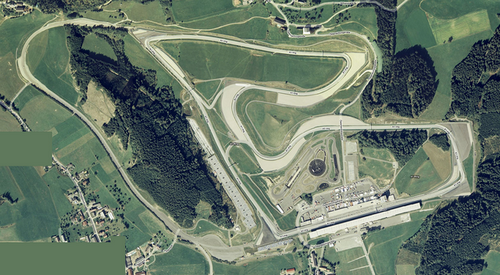
Legendary circuits: the intoxicating Zeltweg toboggan. Posted February 16, 2013. Updated May 5, 2015. By Michael Delaney.
Designated successor of a circuit laid out on the nearby military airfield which had never really convinced Formula 1, the Österreichring became the majestic theater of the Austrian Grand Prix in 1970, a first edition won by Jacky Ickx on Ferrari after the abandonment of local hero Jochen Rindt (Lotus). Staggering and devilishly fast, the track nestled in the Spielberg Hills will be shelved after the 1987 edition due to lack of driver disengagement and precarious safety.
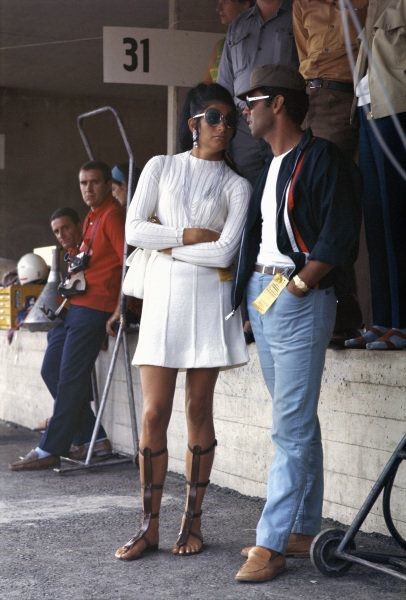
Vintage grid girl. Zeltweg 1969.
Built at the foot of the Austrian mountains, the Österreichring rose from the ground in 1969 not far from the Zeltweg aerodrome, which hosted F1 in 1964.

Ring 1970. Helen Stewart.
Host of the Austrian Grand Prix the following year in 1970, the splendid circuit immediately arouses the admiration of drivers. Its oversized altitude differences, steep turns and colossal average speeds make it the fastest track on the calendar behind the inevitable Monza. But unlike the Italian track, the Österreichring has no slowdown zones, with the slowest corner being taken in fourth gear. Add to that the complete lack of disengagement in the very fast Bosch or Vöest-Hügel curves and you have a man circuit where the slightest slack condemns you to a runners-up finish.
Rendered more and more extreme by the ceaseless progress of the single-seaters, the Austrian circuit will gradually reveal flaws that will lead to its inevitable abandonment. Although fantastic, the rural setting of the Styrian hills has flaws that F1 will no longer be able to accept. Completely virgin protective fields act as a disengagement zone when simple safety barriers punish the adventurous in the fastest and most dangerous corners of the circuit.
If the Österreichring was spared by disasters despite often apocalyptic conditions, as evidenced by the 1975 edition brilliantly won by Vittorio Brambilla with the nose and beard of the greatest, the death of Mark Donohue the following year marked a turning point in the history of the Austrian track. Now cut off from its fastest turn (Vöest-Hügel), the circuit nevertheless retains an inimitable charm and atmosphere that will offer the public thrilling races.
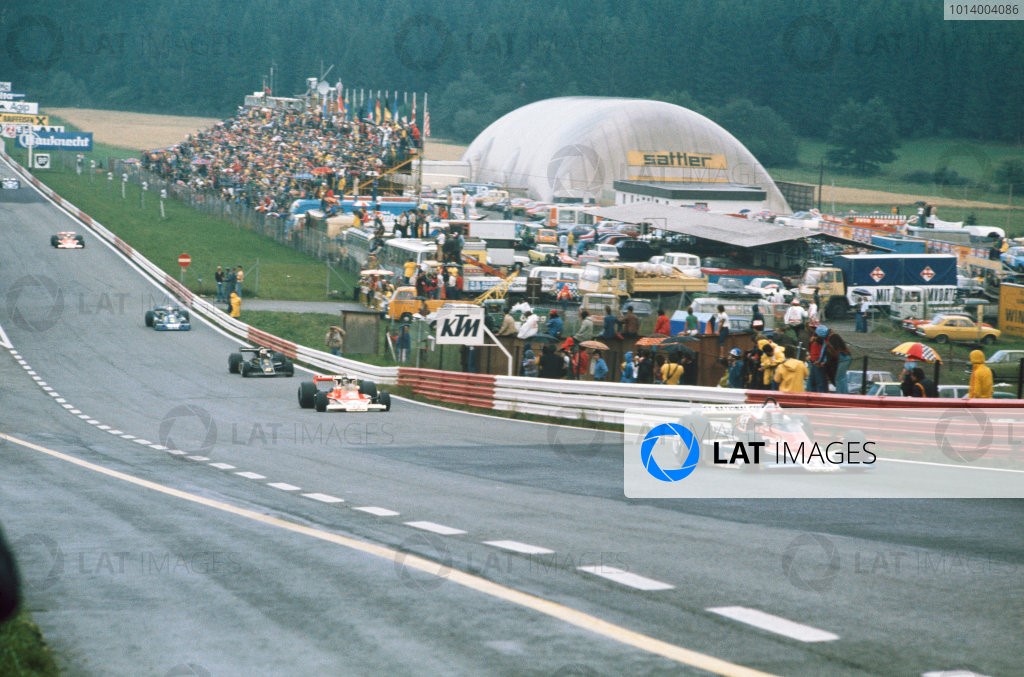
1976 Austrian Grand Prix. Osterreichring, Zeltweg, Austria. 13-15 August 1976. John Watson (Penske PC4-Ford), 1st position, leads James Hunt (McLaren M23-Ford), 4th position at the start of the race, action. World Cop.
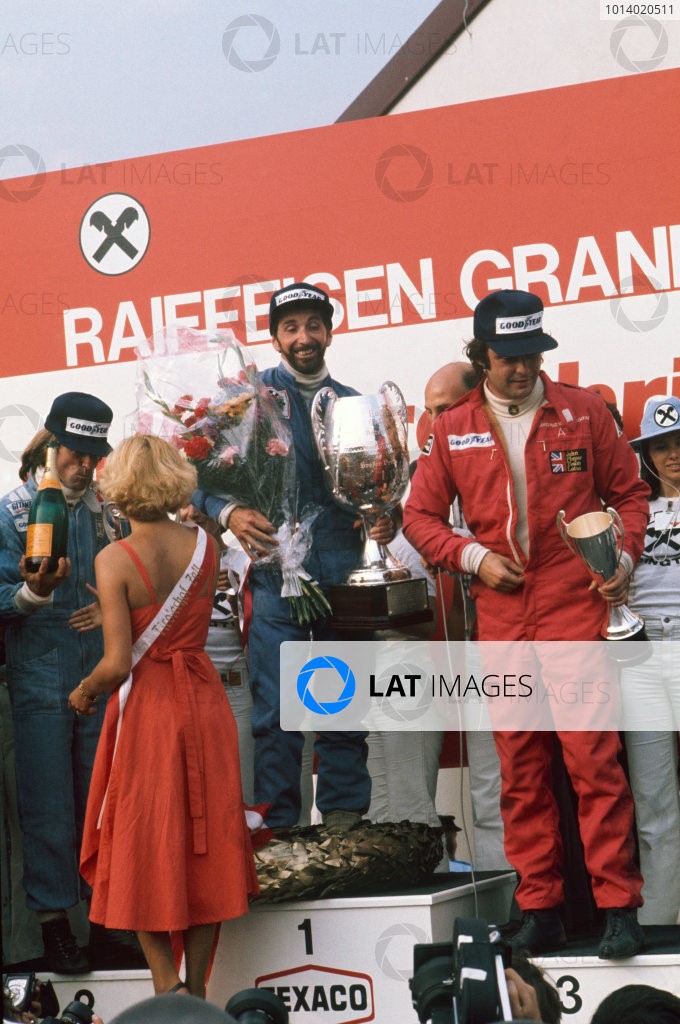
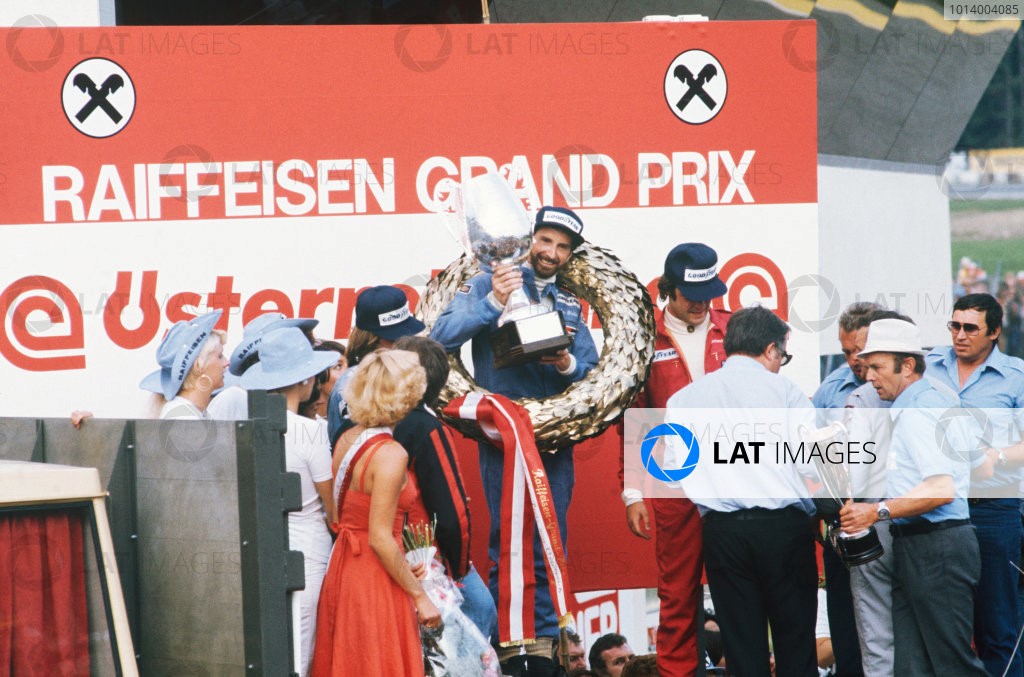
1976 Formula 1 World Championship: Osterreichring, Zeltweg, Austria. 13th - 15th August 1976. John Watson (Penske PC4-Ford), 1st position celebrates taking his maiden Grand Prix win and Penske's only victory with Jacques Laffite (Ligier JS5-Matra), 2nd position and Gunnar Nilsson (Lotus 77-Ford), 3rd position on the podium, portrait. World Copyright: LAT Photographic Ref: 76 AUT 11.
From the heroic success of John Watson (1976), through the triumphant debuts of Alan Jones and Shadow (1977), through the ultimate victory of Ronnie Peterson (1978) or even the stunning finale of 1982 between Keke Rosberg and Elio De Angelis, the Österreichring is a treat for racing enthusiasts. "It was a ballsy circuit," Watson readily admits.
However, the appalling accident of Stefan Johansson in 1987 (hit by a deer at full speed), the abominable pirouette of Andrea de Cesaris on the embankment (1985) and the double pile-up at the start of the last Grand Prix (due to the extreme narrowness of the pit straight) will result in its loss. Abandoned by F1, the Österreichring would return in a deeply modified version ten years later. Completely denatured and castrated by Hermann Tilke, the now A1 Ring will never arouse the same emotions as its illustrious elder and will be forgotten in 2003 after Ferrari's inglorious double the previous year. Recently modernized and renamed the Red Bull Ring (named after its new owner), the Austrian circuit was cited as a candidate for the 20th Grand Prix for a while in 2013 before the region's insufficient hotel infrastructure permanently hampered its chances of returning to the calendar.
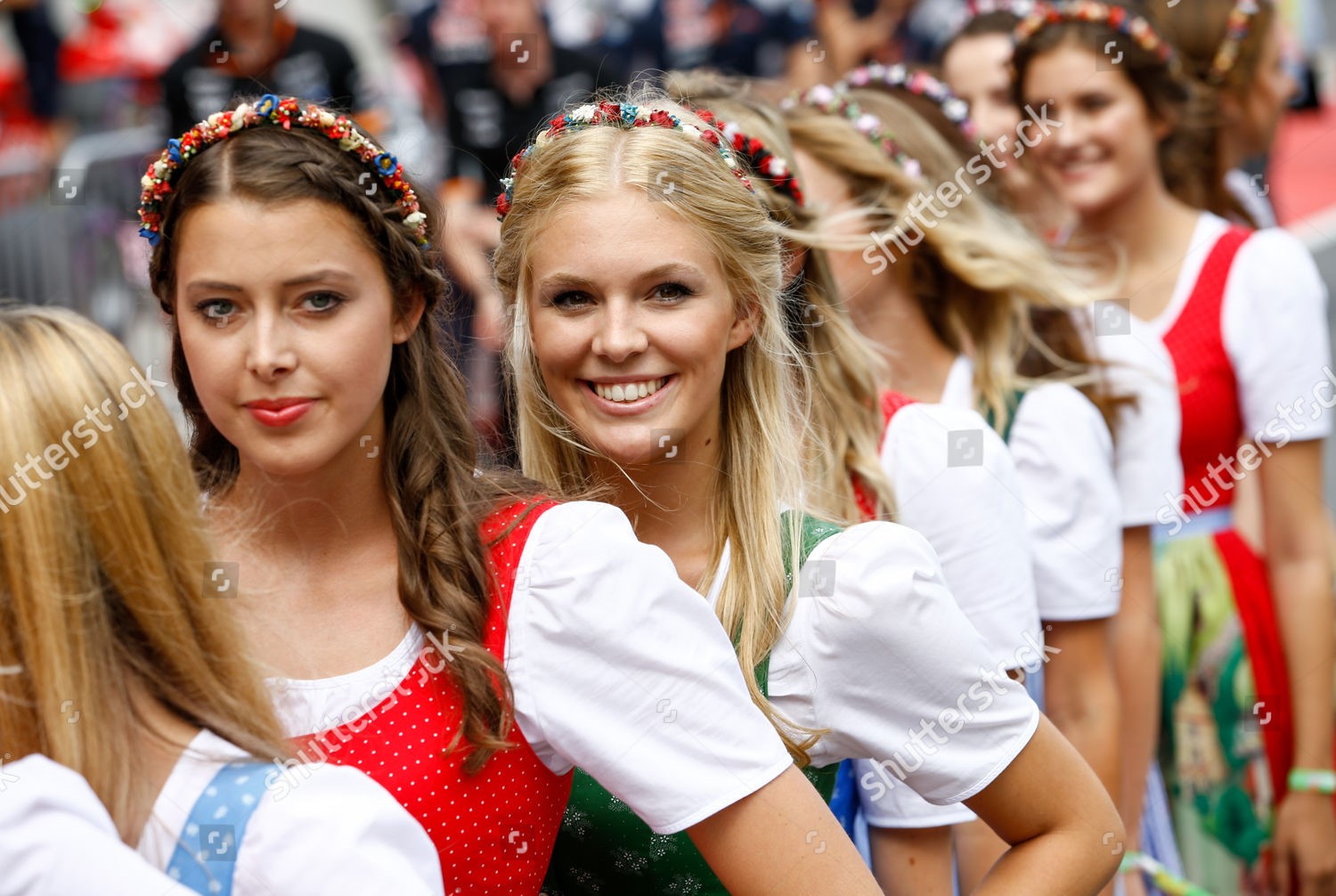
Zeltweg: home to legends. By Alan Henry. Posted on Friday, 09 Aug 2013.
Last month’s announcement that the Austrian Grand Prix will return to the grand prix calendar in 2014 served to remind me of two things.
Firstly, there’s simply no stopping the growth of the Formula 1 circus – and that, even as we (somewhat shakily) contemplate the addition of races in Russia and New Jersey for next year, the arrival of a new round in Europe – and at an old friend like the mighty Spielberg circuit – is massively welcome.
Secondly, a return to Austria – or, at the very least, the announcement that has served as a kickstarter for me to pen this blog – is a timely reminder to F1 historians of the many inter-related strands that underpin McLaren’s involvement in grand prix racing over the years.
It’s now 50 years since the first non-championship F1 Austrian GP took place on the wild, woolly and extraordinarily bumpy Zeltweg aerodrome circuit near Knittelfeld. It was followed up the following year by the country’s first world championship race – on the same makeshift circuit.
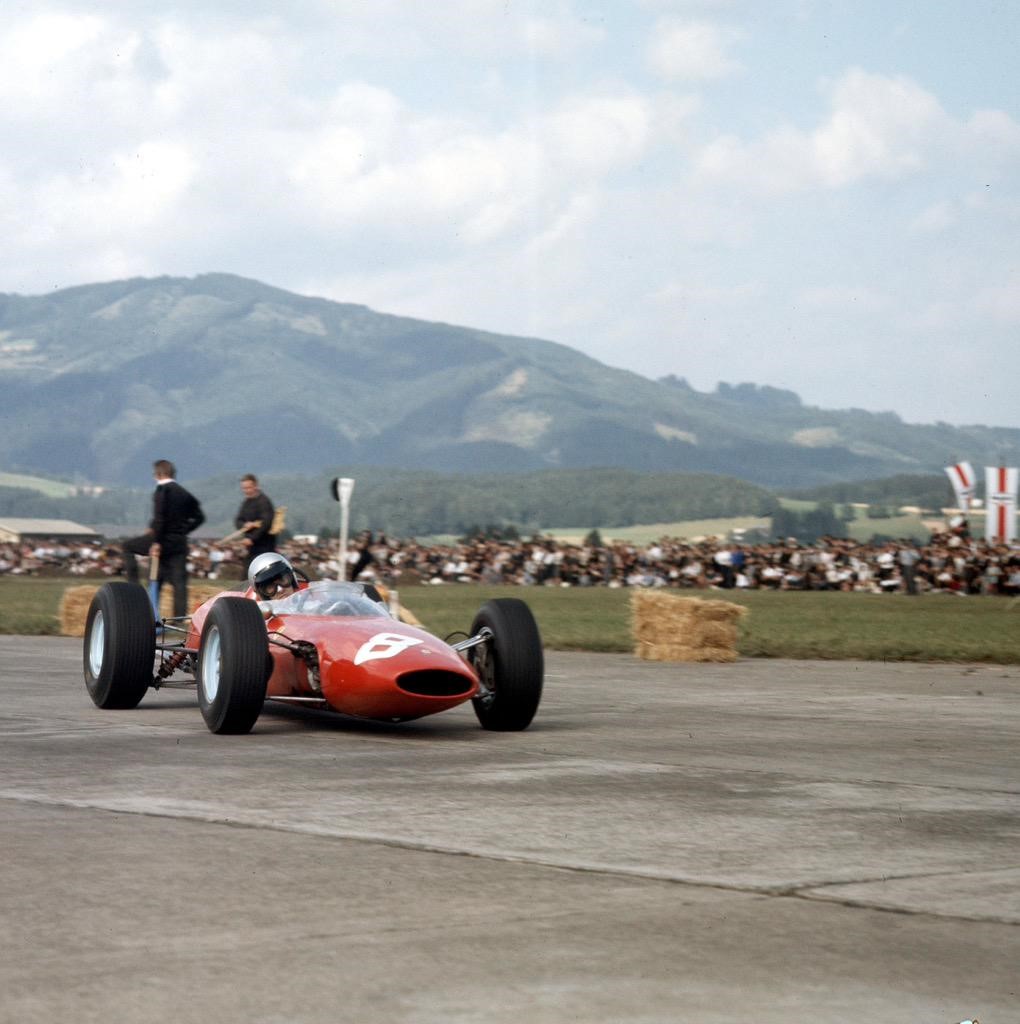
August 23, 1964. Lorenzo Bandini takes only world championship GP win in only race on Zeltweg airfield circuit. ©LAT
That 1964 race saw the emergence in F1 of the country’s new rising star Jochen Rindt. The young Austrian may have been one of the most exciting young talents to arrive in the sport’s most senior category, but opinion was certainly divided about Jochen’s often-abrasive personality.
For his GP debut at Zeltweg in ’64, Rindt cut a deal to drive privateer Rob Walker’s Brabham-BRM and was bright and keen enough to keep his arrogant streak under control. Many years later, Walker told me that Jochen was “all bounce and joy, a charming boy. He was really most attentive. After the [1964] race, he kept ringing me up and asking whether he could drive for me in ’65. But I told him it would be better if he could get in at Coopers because they had a guaranteed entry as a works team.”
Of course, in 1965 Cooper’s other driver was a certain Bruce McLaren.
Naturally, Rindt was quickly alerted to the fact that he could learn a great deal from the thoughtful and mechanically minded New Zealander. He might have learned a lot more, of course, but Bruce began running his own F1 cars in 1966 while Jochen remained with Cooper to see out the second and third years of his contract.
Jochen’s arrogance might have struck an appealing chord with his inner circle of friends, but not everybody enjoyed the Austrian driver’s attitude. One of those was McLaren Group chairman Ron Dennis, who in 1966 was just starting out on a career in motor racing in the role of technician within the Cooper team.
“Yes, Rindt was arrogant and he did not treat people properly – especially the mechanics.” Ron once told me. “I recall at the 1967 German GP [team principal] Roy Salvadori telling him he’d better hurry up and get ready because it was almost time for the start.
“Rindt just looked at him and replied, ‘they wouldn’t dare start the German GP without me!’ As he said it, one of the other mechanics looked up and muttered rather acidly, ‘why don’t you pop down the road with your helmet and fill it with ten pounds of potatoes?!’”
For Ron, it most certainly wasn’t a meeting of minds, but both Rindt and Dennis switched to the Brabham team for the 1968 season – although Ron insisted that he work on Jack’s car rather than Jochen’s.
“I have to say,” he mused thoughtfully, “I don’t have great memories of Jochen.”
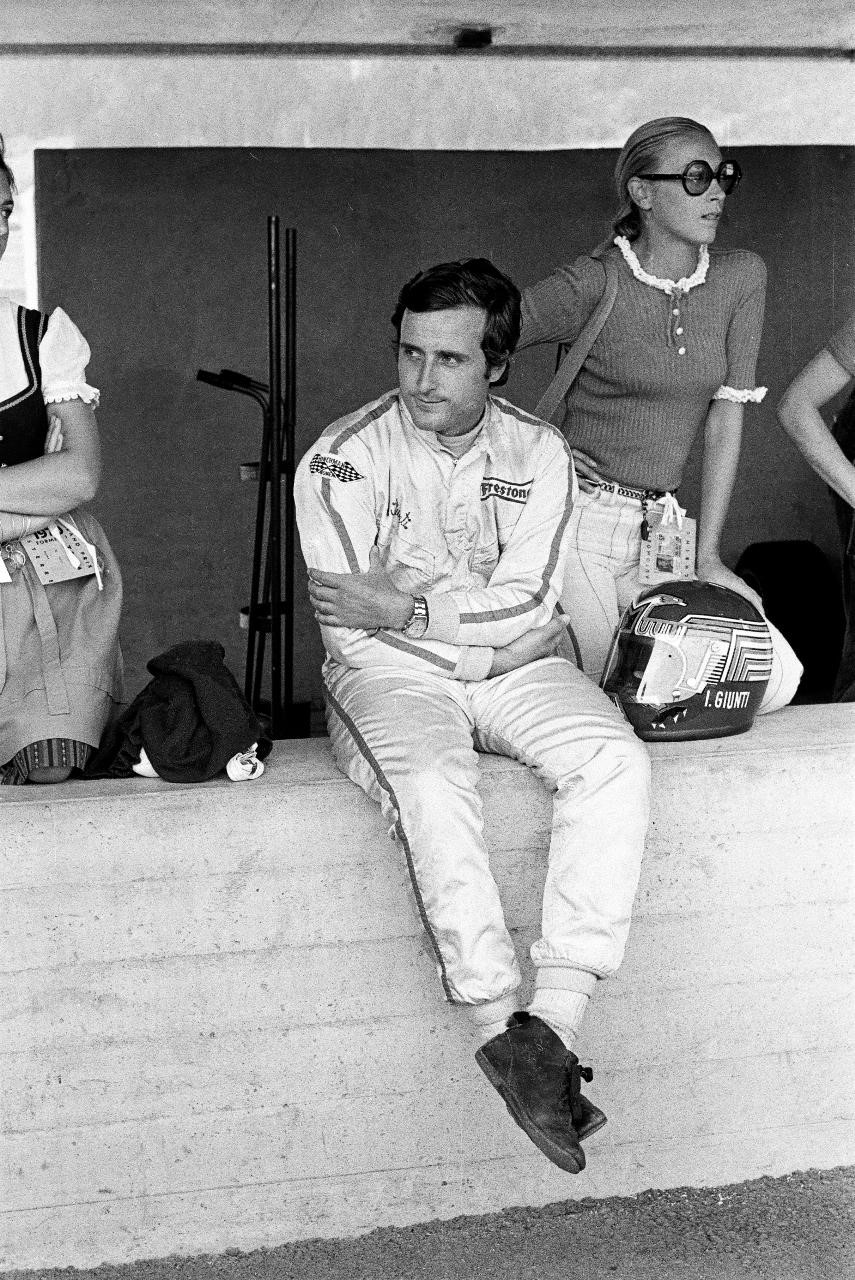
Zeltweg 1970. Ignazio Giunti and his girlfriend Mara Lodirio.
For 1970, the Austrian Grand Prix found a new home – confusingly also at a track known as Zeltweg, as it was situated just across the road in the hills overlooking the old runway track. However, while this new circuit may have shared its name with its unexciting predecessor, the track remains what many consider the ‘proper’ Zeltweg – a hugely fast and flowing track hewn into the rolling meadows and forests in the foothills of the mountains that pepper central Austria.
It was at this Zeltweg, also known as the Osterreichring, that the F1 world championship established its long-term home – only losing the race after the disastrous 1987 edition, which was ultimately started three times after the field was decimated by two massive startline crashes. The 1987 race was also the weekend when Stefan Johansson encountered a deer in the middle of the track after cresting a blind rise during Friday qualifying.
Poor Stefan survived the accident, although his car was severely damaged and little remained of the deer, which was hit square-on by the left-front wheel.
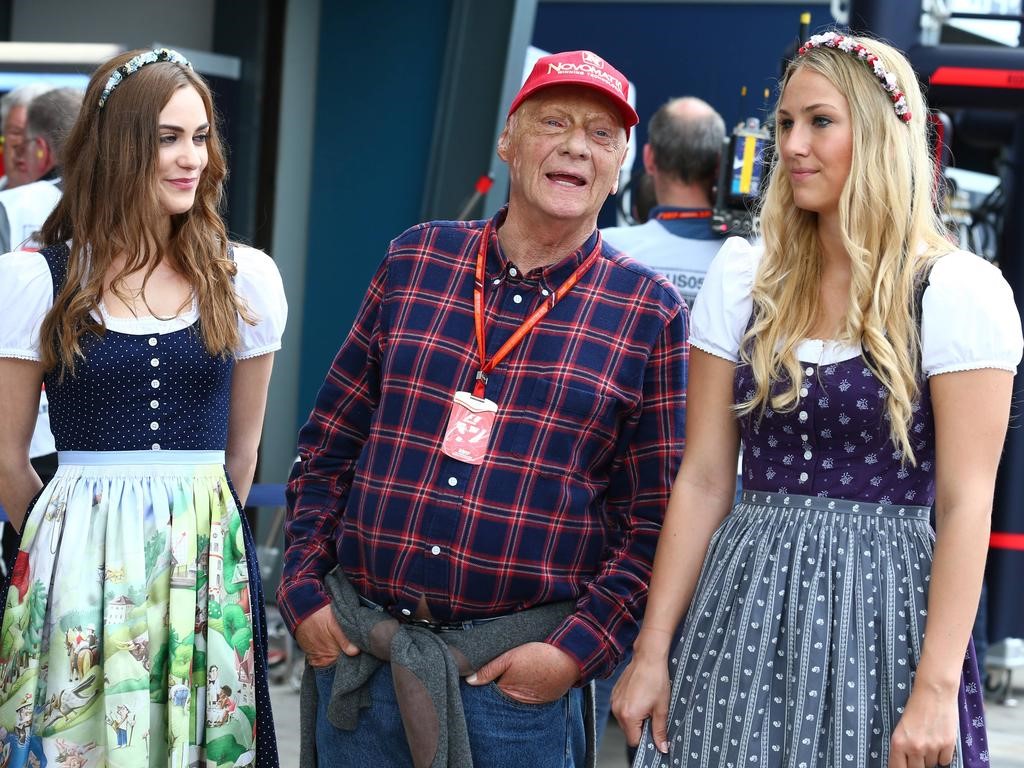
Niki Lauda with two grid girls.
It was at the Osterreichring that Austria’s most famous motor racing son, Niki Lauda, won his one and only home grand prix, in 1984 after famously hanging on to beat Nelson Piquet’s Brabham despite his TAG turbo-engined car limping round the last few laps jammed in fourth gear.
You can never keep a good man down, however and while the Osterreichring may have slipped from view in the late 1980s, it returned – with a truncated name and a shorter configuration – in 1997, newly rechristened the A1-Ring.
McLaren won at each venue three times – making them Zeltweg’s most successful constructor – and will be returning to the Styrian mountains keen to maintain that reputation.
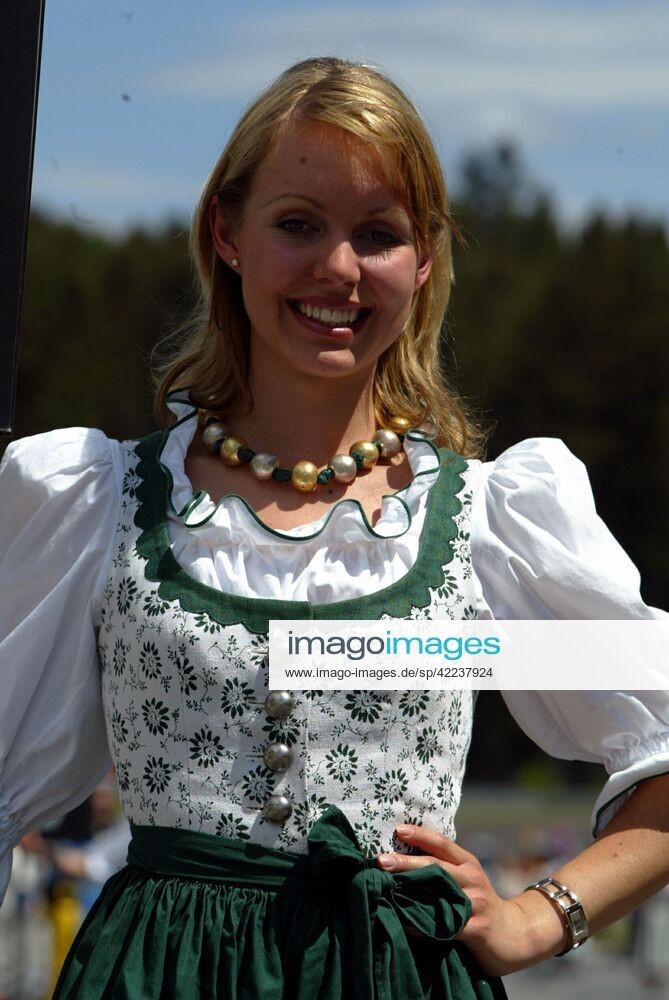
Austrian Grand Prix, Race Day, A1-Ring, Austria, 18 May 2003.
It will be interesting to return to Zeltweg – F1 has changed substantially since last it visited (back in 2003, when the race was won by Michael Schumacher) and the attendant circus has grown considerably.
I hope that the circuit can still retain its cosy charm.
I always found the Zeltweg paddock rather snug – it didn’t have the big-world ambitions of the newer circuits that were springing up around the world at the time; it was a small, tight little place where you got the distinct impression that it was there for a singular purpose – to host great motor racing.
Which, of course, it did in abundance.
My overriding memory of the paddock in Spielberg was the crisp mountain air. Arriving from our hotel (already a lengthy motorway drive from the nearest international airport in Graz) in the morning invariably meant driving along empty Austrian autobahns, rolling through endless mountainside tunnels and emerging to peer at distant snow-capped peaks. The paddock itself was always hidden in shadow during those mornings, when you’d be wise to pack a jumper before searching the motorhomes for a spot of breakfast.
By lunchtime, the sun had arced overhead and the track was bathed in brilliant sunshine, made purer by that crystal-clear mountain air.
In all its incarnations, it really was a glorious place to go motor racing.
Niki Lauda has hit out at Red Bull for dropping his name from a corner at the returning Austrian grand prix venue.
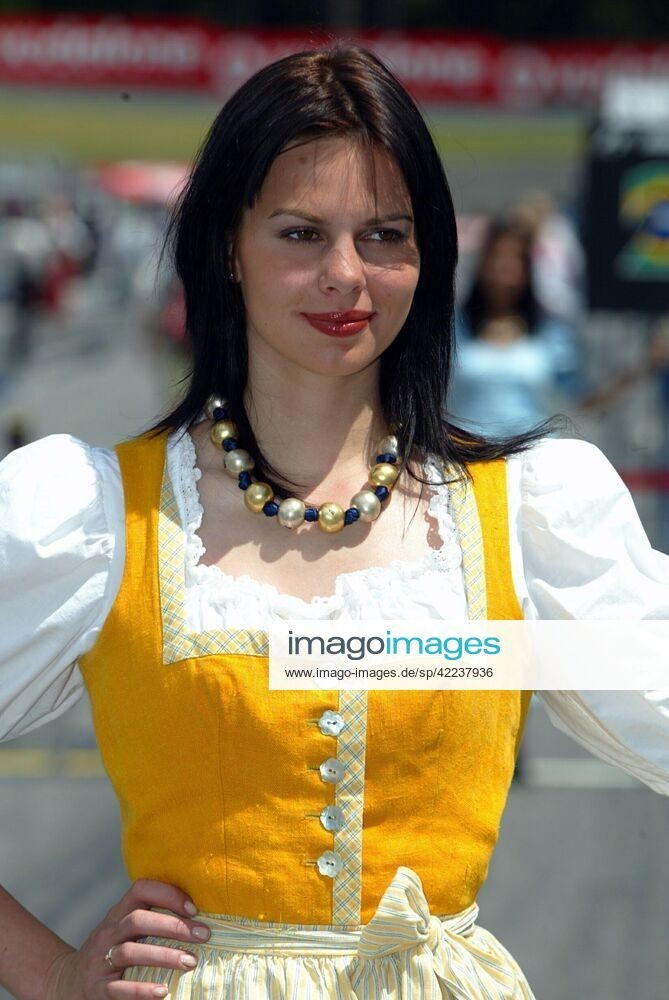
Austrian grid girl at Austrian GP on 18 May 2003. Motorsport images
Now called the Red Bull Ring, the former A1-Ring was demolished and totally rebuilt by the energy drinks company and next month it will host its first grand prix since 2003.
Prior to the Red Bull takeover, one of the corners at the A1-Ring was called the Niki Lauda Kurve, in honour of the Austrian great and triple world champion.
Now, the same corner has been renamed Pirelli. Also gone is the Gerhard Berger Kurve, replaced by Wurth, a German tool company.
"I'm very disappointed," Lauda told Kleine Zeitung newspaper.
"I can only presume it is because I am now at Mercedes and we are beating Red Bull," he added.
So far, the Jochen Rindt Kurve - named after the posthumous 1970 world champion - has survived the Red Bull Ring's search for sponsor dollars.
But correspondent Gerald Pototschnig said even that corner could be renamed if a sponsor makes an attractive enough offer.
"As punishment," the angry Lauda said, "Mercedes will be happy to celebrate a one-two in Spielberg."
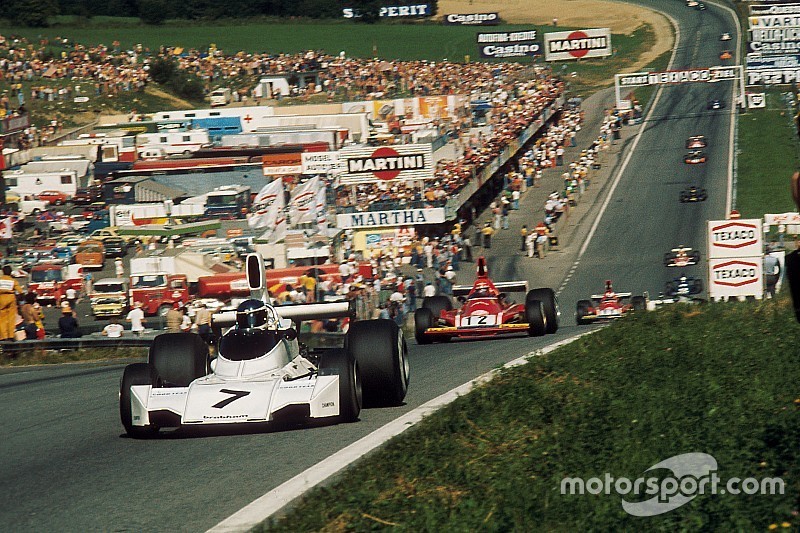
F1 Austrian GP 1974. Carlos Reutemann, Brabham BT44 Ford, leads Niki Lauda in a Ferrari 312B3.
10 best moments from the Austrian Grand Prix. © Rainer Schlegelmilch/Getty Images. We look back at the 10 most spectacular, controversial and memorable moments from the Austrian GP. Written by Werner Jessner. Published on 17.06.2015.
1970: Jochen Rindt's last race.
The record books show this as a Ferrari one-two with Jacky Ickx finishing six tenths of a second ahead of Clay Regazzoni and Brabham’s Rolf Stomelen taking his first and only podium. But none of that was in the script. The first Grand Prix at the Österreichring was supposed to be Jochen Rindt’s race. It was his first home Grand Prix on Austria’s new home for motorsport: a purpose-built circuit to replace the circuit at Zeltweg airfield. Everybody wanted to see the world championship leader take his Lotus to victory in his own back yard, but a technical problem sent him out of the race. The next fault was to cost him his life and the 1970 Austrian Grand Prix was to be the last race won by F1’s only posthumous World Champion.
1975: Brambilla goes from winner to loser!
One of the most eventful Sundays in F1 history. First Mark Donohue’s front-left tyre blew, sending him off the track and causing an accident – sadly a day later Donohue lapsed into a coma and died. The race itself was a thrilling battle in the rain. The conditions were so difficult that officials considered cancelling the race. At the end of the race, Vittorio Brambilla was leading. As he took the chequered flag, he took both hands off the wheel to celebrate and promptly crashed his March into the pitwall. It would be the only win of his career. Local favourite Niki Lauda started from pole and finished just ahead of his Ferrari team-mate Clay Regazzoni, leaving him needing just one more point to secure his first world title.
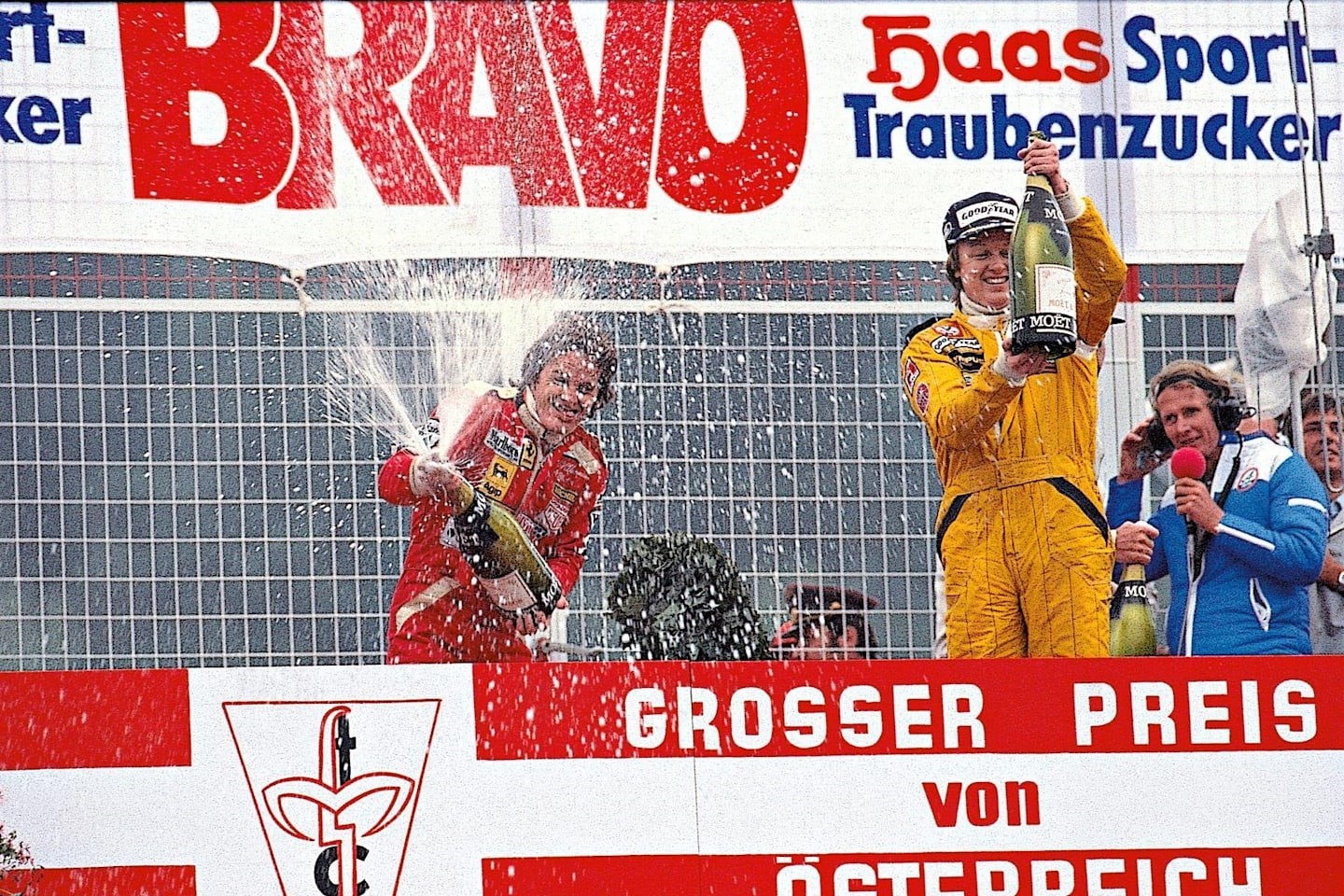
Ronnie Peterson and Gilles Villeneuve in 1978. © Rainer Schlegelmilch/Getty Images.
1978: Confusion rains.
It was damp at the start of the race and got wetter and wetter. As torrential rain turned the track into a giant water slide, cars began crashing and sliding off the circuit. It didn’t help that when they rejoined the mayhem, they dragged mud onto the track making it even slipperier. On the eighth lap there was so much chaos that the race needed to be restarted but as the cars left the starting grid, there was another pile-up. In the end, just nine cars crossed the finish line after a restart, led by Ronnie Peterson in the Lotus while Ferrari’s Gilles Villeneuve scored his first podium in F1.
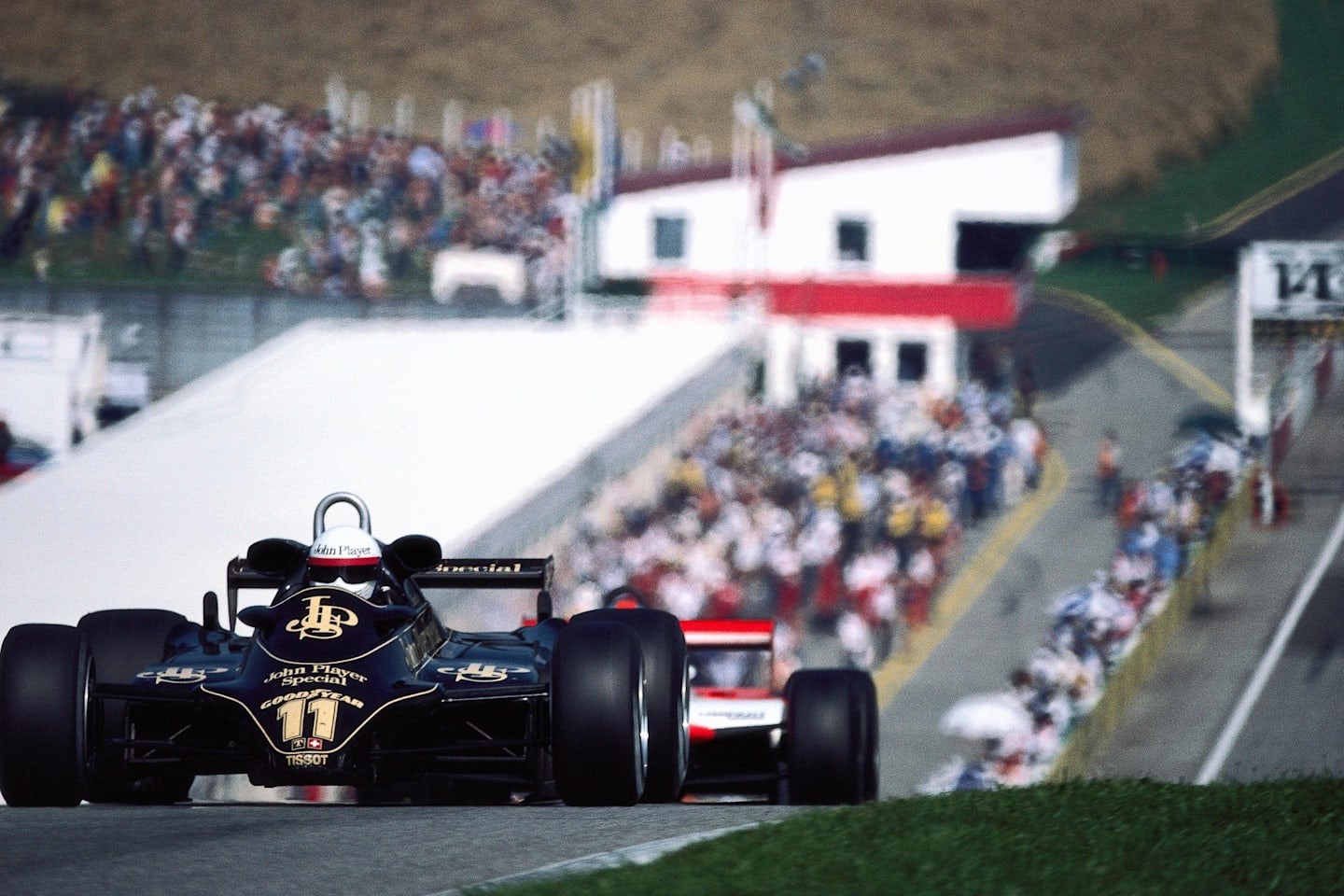
Elio de Angelis takes victory for Lotus in 1982. © Rainer Schlegelmilch/Getty Images.
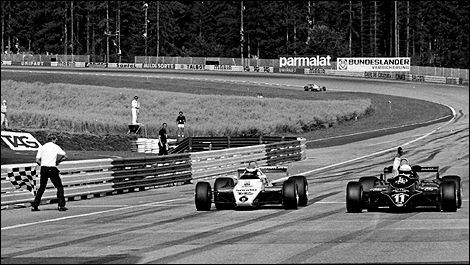
Zeltweg 1982. First victory of Elio de Angelis, ahead of Keke Rosberg, for 0.05 second. Photo WRi2.
1982: Colin Chapman celebrates for the last time.
F1 has always been at the cutting edge of new technology but that technology doesn’t always work right out of the box. In 1982 nascent turbo power was powering the Renault and Brabham teams to the front but in Austria all four front runners Riccardo Patrese, Nelson Piquet, René Arnoux and Alain Prost were forced to retire by technical gremlins. That allowed the normally aspirated cars of Elio de Angelis (Lotus) and Keke Rosberg (Williams) to pounce. Rosberg went on to win the world championship that year. He only scored one win but he finished consistently higher than anyone else. But it was the Italian who triumphed on the Österreichring, crossing the finishing line a mere 0.12 seconds ahead of the Finn. Lotus founder Colin Chapman threw his hat in the air in his customary celebration, but it was to be the last win he would see before his death from heart failure that winter.
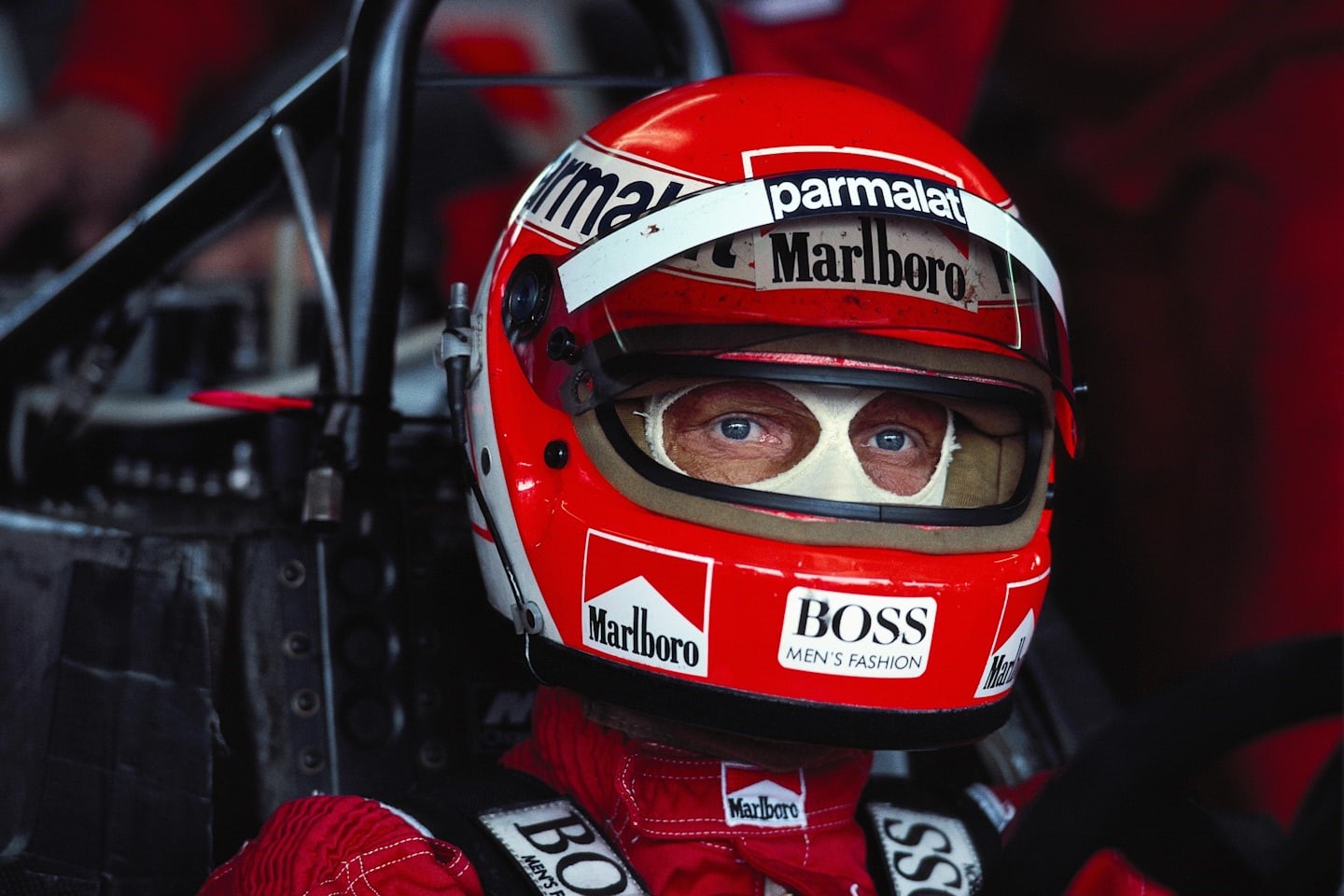
Niki Lauda: the only Austrian to win his home race. © Rainer Schlegelmilch/Getty Images.
1984: Niki Lauda brings it all home.
The whole of Austria was caught up in the drama – an Austrian had never won his home Grand Prix and more to the point, the world championship was in the balance. Two-time champion Niki Lauda had made a comeback to F1 with an ambitious McLaren team, paired with a brilliant Frenchman Alain Prost. They were up against reigning world champion Nelson Piquet in the Brabham. In Austria, Prost retired early but Lauda lost a few gears in the final third of the race. Piquet began to close but hesitated, thinking that Lauda must be racing tactically and held back. At the end of the season, Lauda won the world title by half a point, the narrowest margin in F1 history, so perhaps Lauda’s home win was enough to take the world championship.
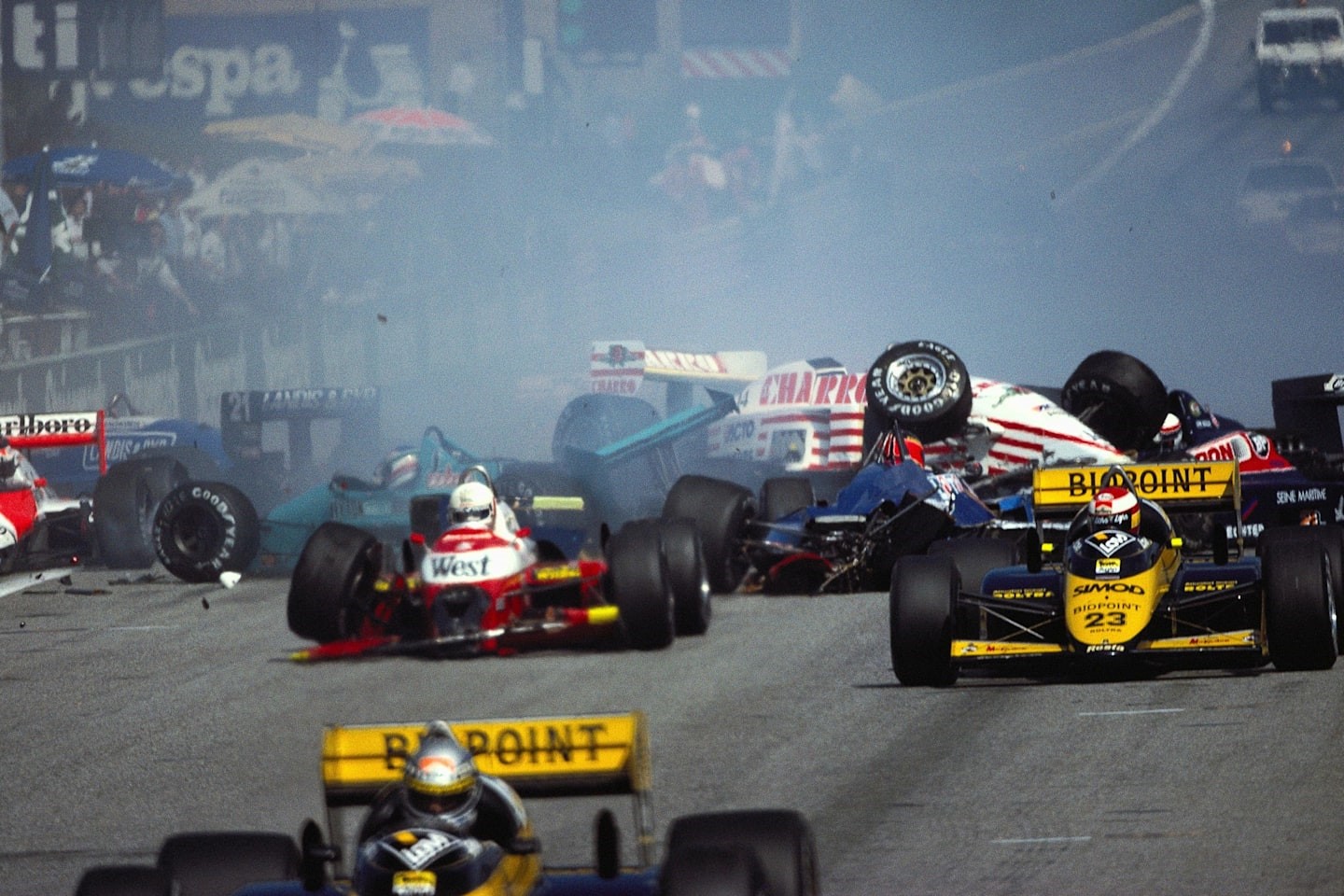
Chaos at the restart of the 1987 Austrian GP. © Rainer Schlegelmilch/Getty Images.
1987: the big pile-up.
This was the last race held on the original ultra-fast Österreichring and it began with a collision between McLaren’s Stefan Johansson and a deer (the deer lost). The race itself began with more mayhem. Firstly Martin Brundle torpedoed several other drivers on the undulating start-finish straight and on the restart, Nigel Mansell and Gerhard Berger got away slowly and the rest of the field crashed into the back of them. More than 10 cars were damaged in the two collisions – before the race was finally underway.
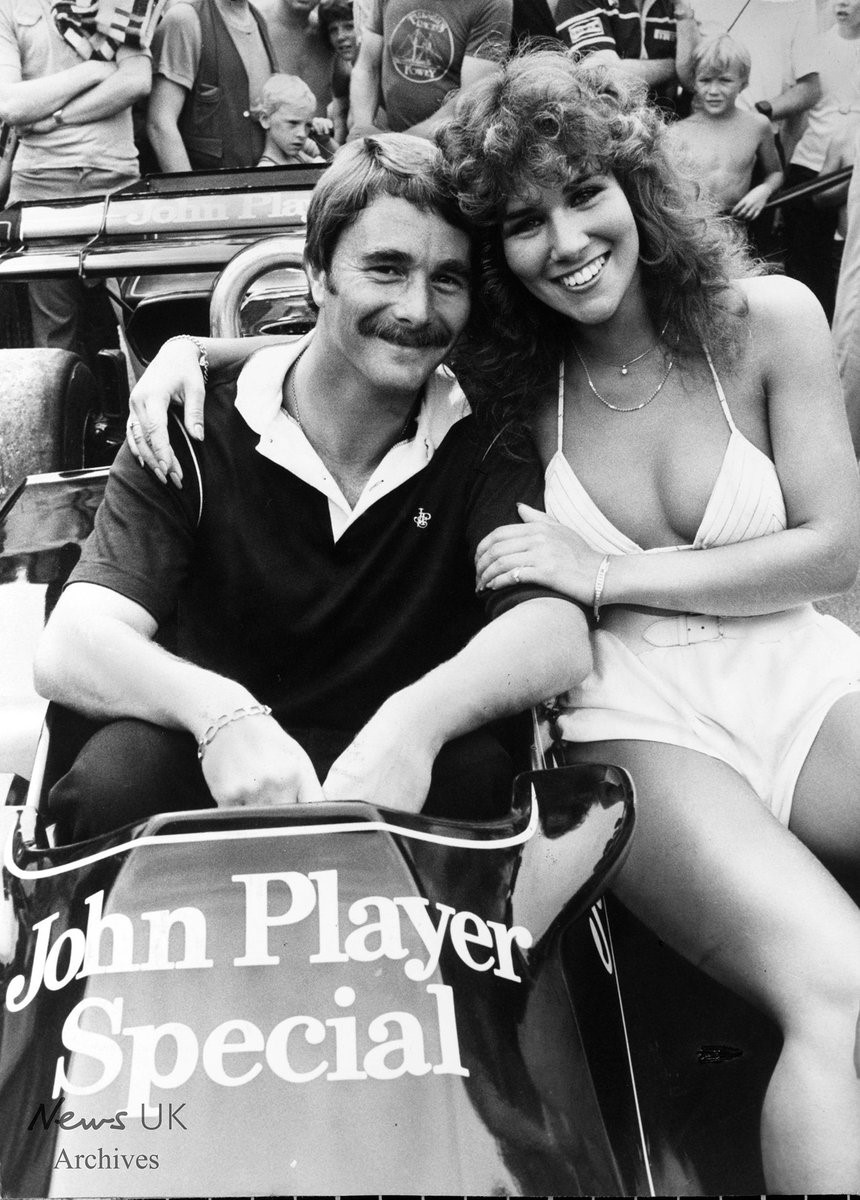
The Sun Free Race Day at Brands Hatch,UK on Sunday 31st July 1983. Attending was Lotus F1 driver Nigel Mansell and the Sun's Page 3 model Linda Lusardi. Photo by Melvyn Pettit.
For the record, Mansell won for Williams.
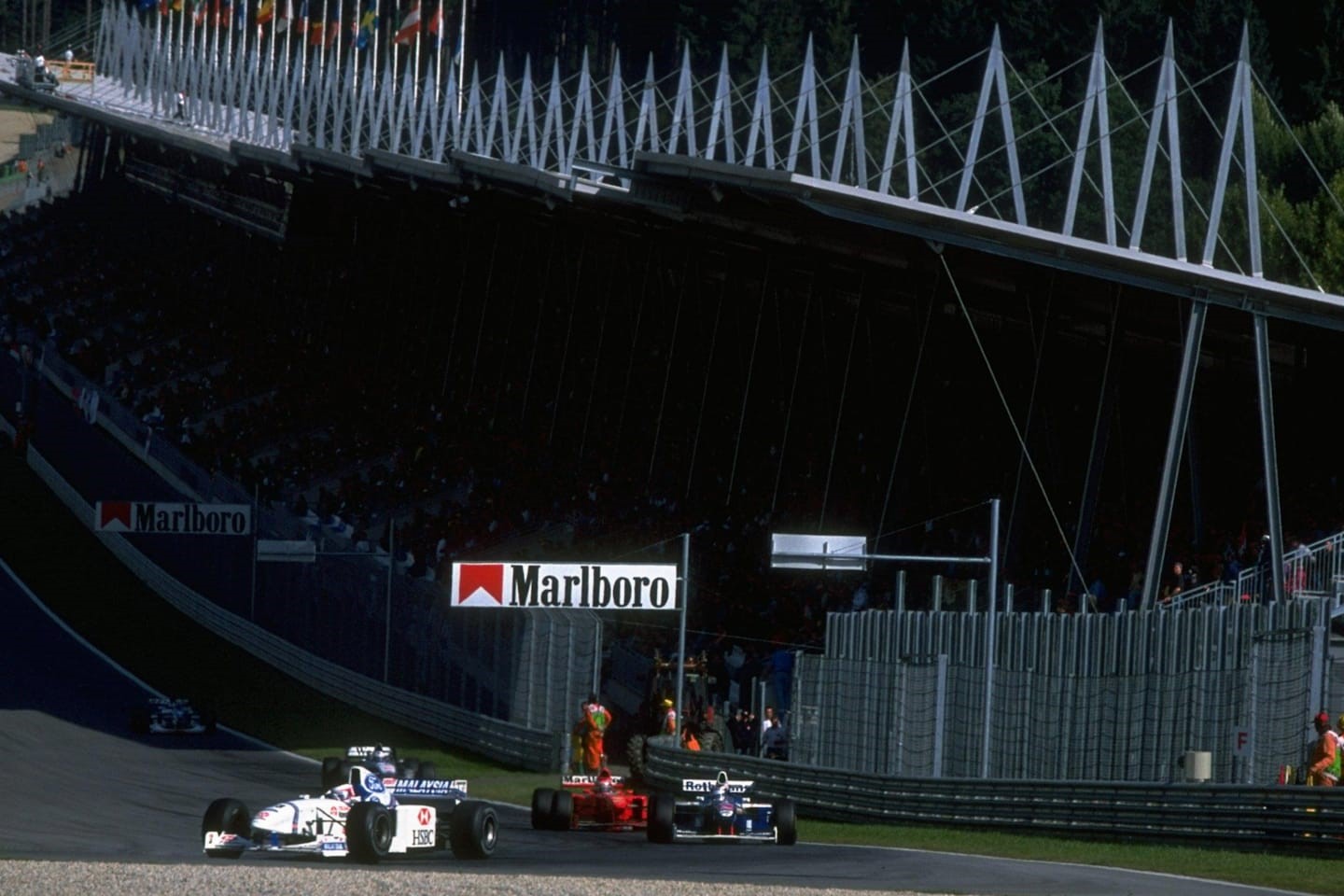
The return of the Ring in 1997. © Michael Cooper/Getty Images.
1997: the return of the Ring.
The Österreichring returned with a new look and a new title sponsor. The new A1 Ring was much shorter, but much safer. The passage to Flatschach was gone, so was the notorious Hella-S passage and the quickest straight in Formula One on Schönberg, which cars had once raced up to 350 kph on. But the fans embraced the new times and so did the drivers – the first winner on the new layout, which is still in use today, was Jacques Villeneuve, who would go on to take the world championship that year with Williams. JV is still a popular man in the area today and returned for the inaugural race on the Red Bull Ring last year.
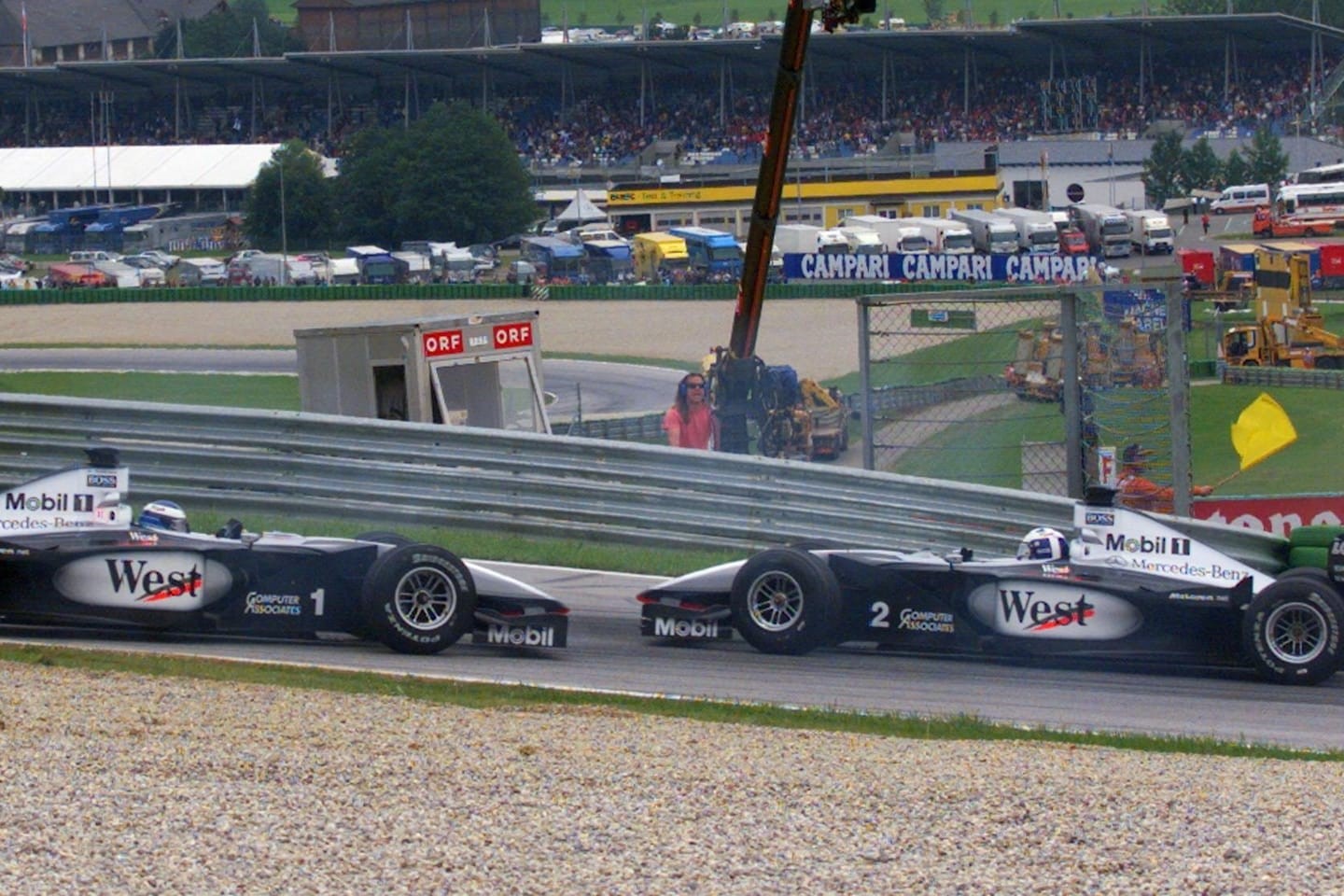
Mika Hakkinen gets it back to front. © Getty Images.
1999: Häkkinen backin' in.
After his crash at the British Grand Prix, Michael Schumacher was out of F1 (temporarily) with broken legs. That left his team-mate Eddie Irvine and deputy Mika Salo leading Ferrari’s title challenge. Everyone predicted the dominant McLarens of Mika Häkkinen and David Coulthard would clean up. They were more than a second quicker than the rest and blocked out the front row after qualifying. The only person who believed he could upset the balance was Irvine. At the start, Häkkinen span and had to let the entire field go by before he could rejoin. With Jean Todt and Ross Brawn calling the strategy from the pitwall, Irvine overtook Coulthard for the lead. While Häkkinen spectacularly worked his way back up to second place, but couldn’t find a way past the Irishman, who seized his chance and launched his own title bid.
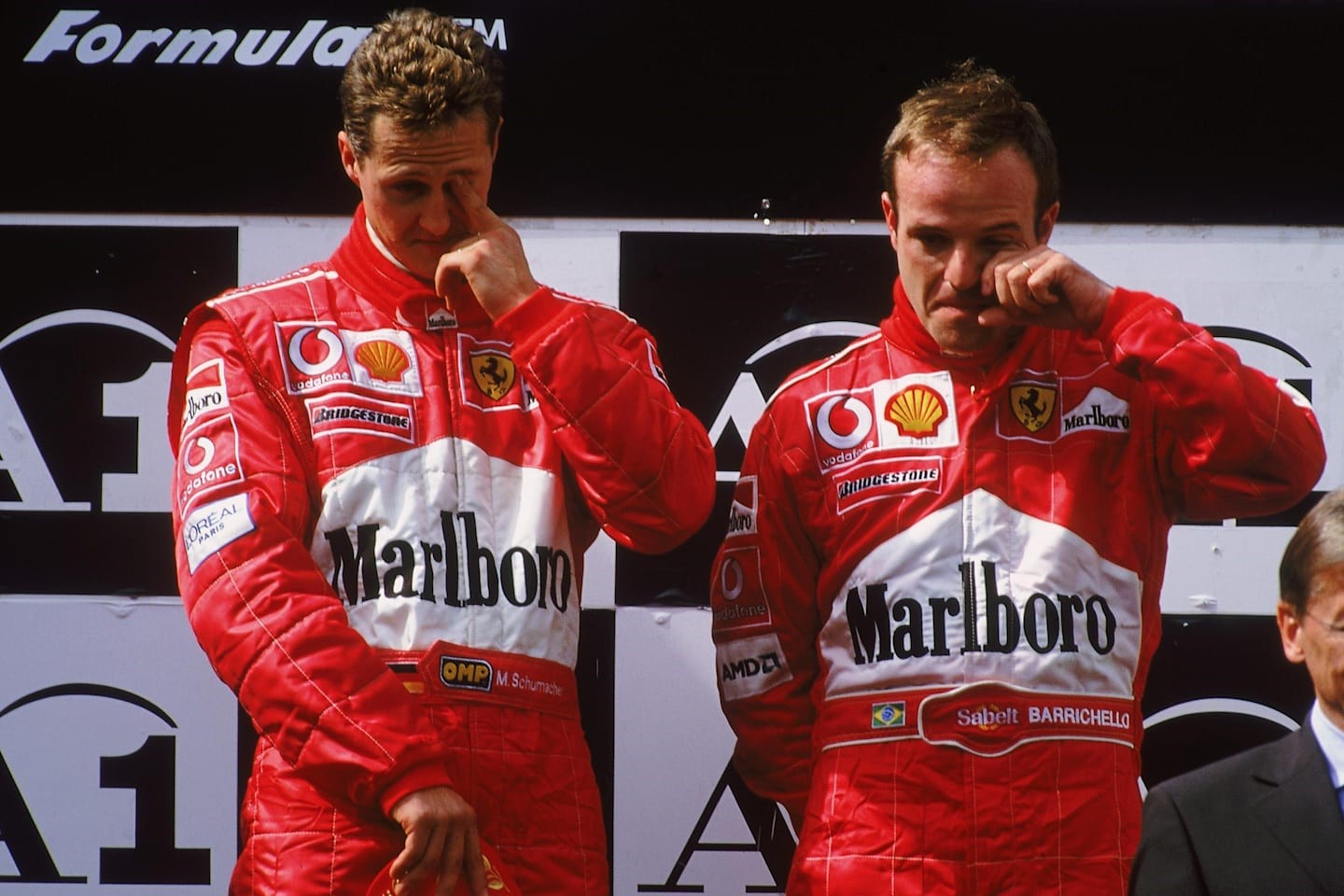
The win that never was Schumacher and Barrichello. © Getty Images.
2002: Let the right one win.
It was another world championship battle between Michael Schumacher (Ferrari) and Mika Häkkinen (McLaren). Irvine was gone, replaced by Rubens Barrichello, under strict orders to assist his team-mate at all costs. But Barrichello proved that on his day he could get the better of the four-time world champion and worked out a comfortable lead right up to the final lap. He then had to give way to the infamous Ferrari team orders: “let Michael pass for the championship.” The Brazilian let him pass at the very last turn, the fans booed. On the podium, a clearly embarrassed Schumacher awkwardly stepped aside to cede the top step to Barrichello. The world title (that Schumacher was already leading) followed and team orders were outlawed soon after. No victory at Spielberg has ever left such a nasty aftertaste.
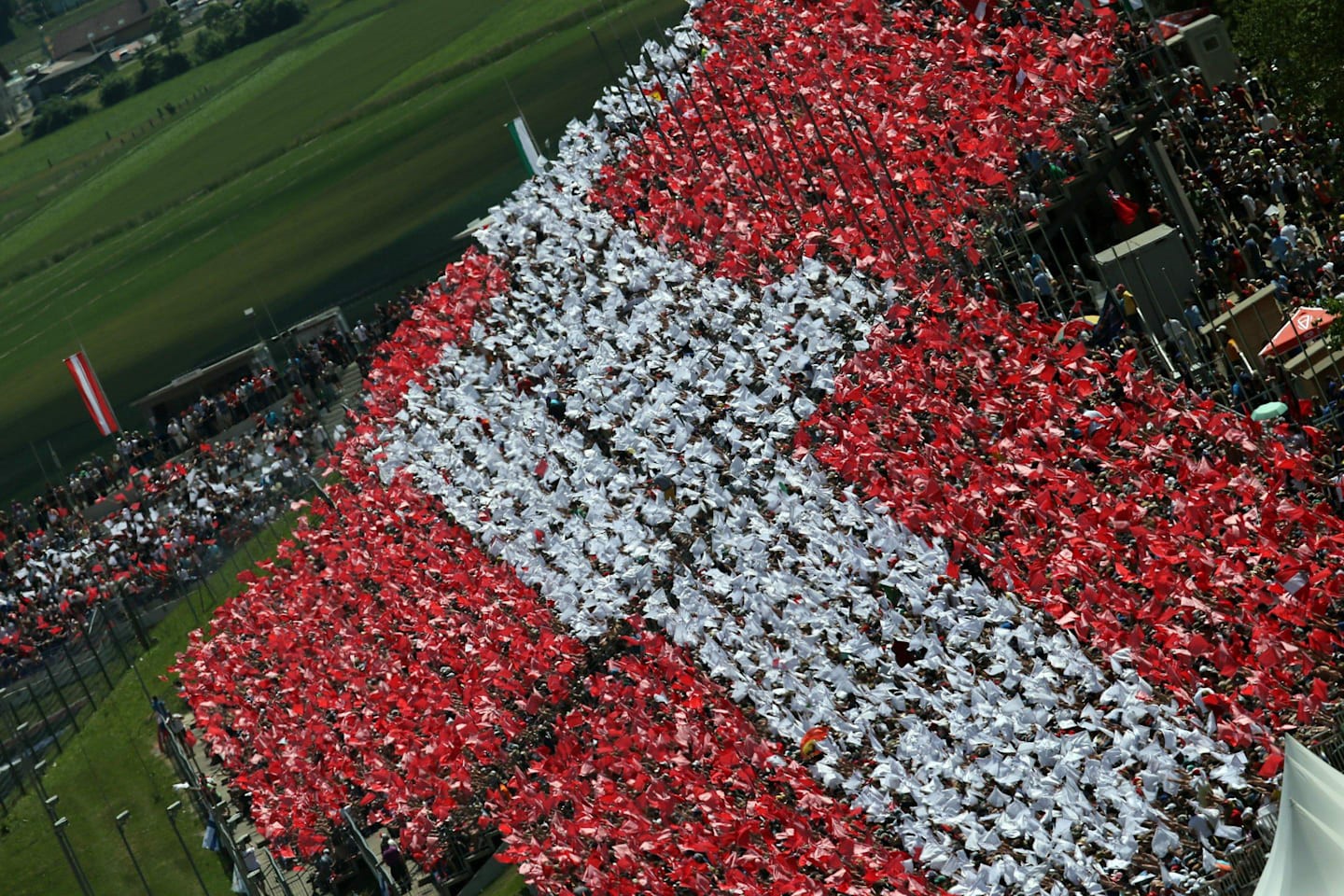
Fans form an Austrian flag at the Red Bull Ring. © Getty Images.
2014: triumphant return.
The return of F1 to Spielberg after an 11-year break turned out to be a triumph. The new Red Bull Ring raised the bar for standards of racing and hospitality in all areas – as a modern, safe, comfortable and stunning new circuit – and with a huge selection of activities and entertainment laid on for the fans. Spielberg has always considered itself to be a heartland of F1, over four decades. Finally the local enthusiasm for the sport could find an outlet again and their response was unbelievable.
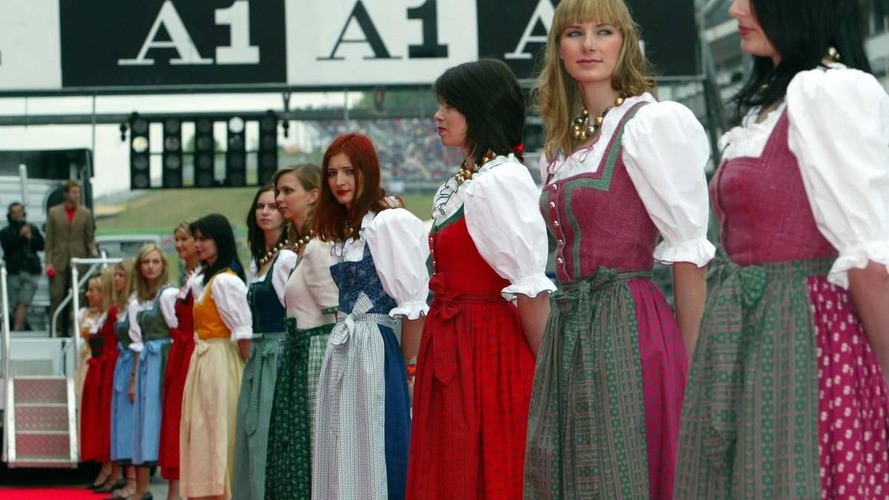
Grid girls Austrian GP.
Focus on… Austria 1985. 18 June 2015.
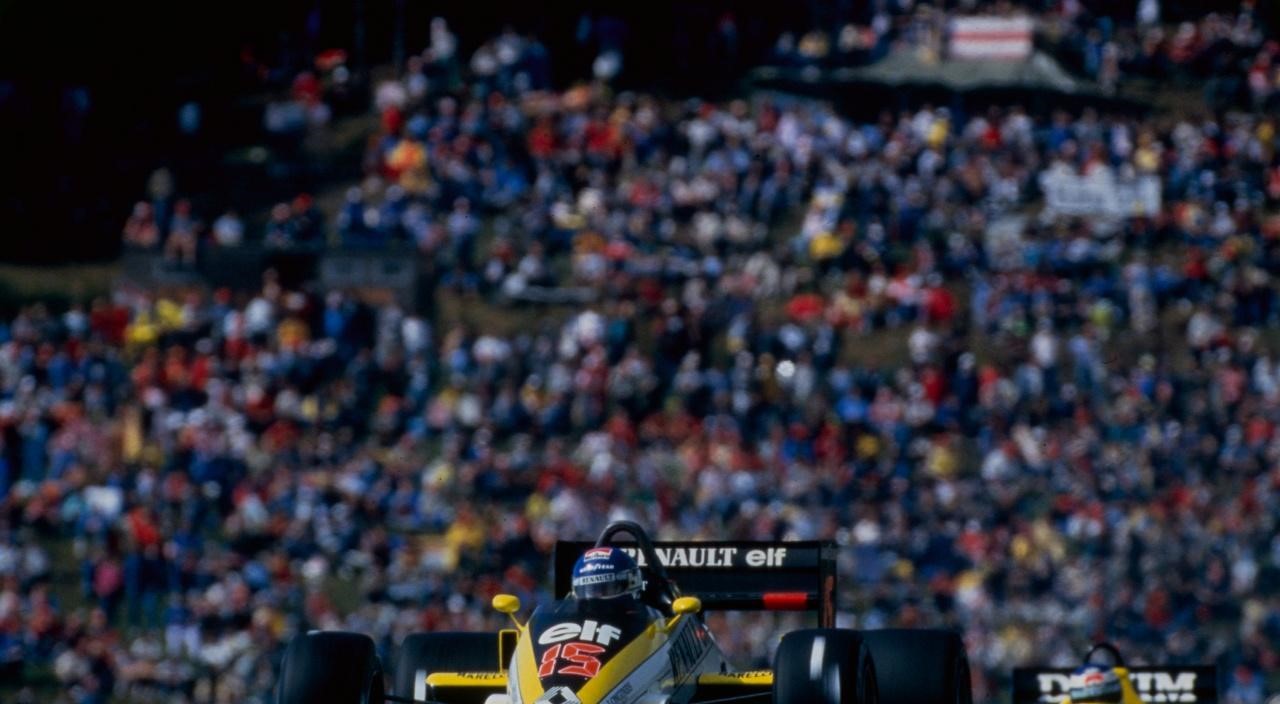
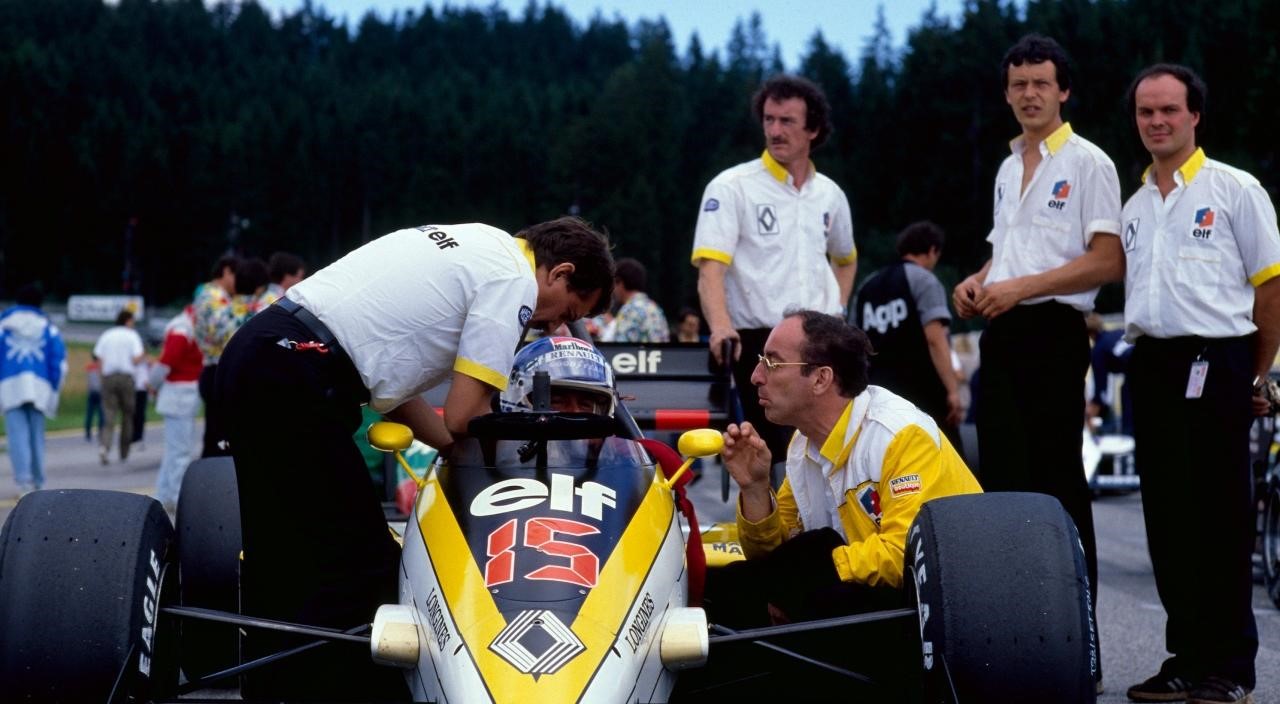
The Red Bull Ring may be a relatively new addition to the F1 calendar, but it has a long and rich history.
The ur-circuit, the Österreichring (or Zeltweg as it became known, after the local town), hosted the Austrian Grand Prix from 1970 until 1987, before a shortened version rejoined the series in 1997 for another seven years. The original track was a behemoth: almost 6km of fast, flowing curves that hugged the contours of the Styrian hills. Bernard Duffort, an electrical engineer with Renault Sport F1, remembers the challenge it presented for the field at the time.
“The original Zeltweg circuit was a very natural track as there was lots of greenery and it was in the hills. The undulation of the countryside produced a great track with short straights and lots of fast turns. But some corners were quite steep, or fell away a lot, so the track was quite dangerous. The pit straight was particularly problematic as it went slightly uphill and was quite narrow. There seemed to be a lot of accidents and you really had to be careful.
‘For the engine engineers we had particular issues with the original turbo engines, specifically with regards to the altitude. You have to remember that Zeltweg was not the highest circuit we visited in those days – Mexico was 2,700m and Austria between 700m and 800m. Even so, we needed to use the turbo differently at this altitude. We had to find the right compromise in the choices we made concerning the compressor and the turbine, that we could couple together to get a better optimal power output. At Zeltweg we had bigger compressors to give a better pressure despite the lack of ambient pressure.
‘Starting the engines, especially in the cold Austrian mornings, was also quite a challenge. At the time we did not pre-heat the water or oil, we just increased the oil pressure at the time we wanted to start. We also had two types of engine, which made it even harder; one for qualifying and one for the race. The quali engine had a compression ratio that was very, very low but it meant that we could run the turbo with more pressure. These engines produced at least 1,200bhp and lots of power, but if we tried to start the engine without heating the water first it was practically impossible to start. In this start-up phase the engine barely turned over, used so much fuel and made a hideous amount of smoke – it was not great to be in the pits at that point! Warming was introduced after this and really improved the situation.
‘When the water had heated up to 40°C, it started to work a bit better, but the usage curve was very difficult to master, particularly when you left the pits. These quali engines were so much more powerful than the race engine, which operated at more reasonable levels to ensure longevity and improved fuel consumption.
‘The ‘pointy’ engine and the corners made it a relatively dangerous track to drive on. Certain corners were particularly steep and drivers needed to be very careful in case of any off track excursions. I remember one time in 1985 that Andrea de Cesaris, who was driving a Ligier powered by the Renault engine, went off track on a fast left hander onto the grass.
There were several bumps in the grass and there had been some rain so it was slippery and very muddy. Instead of sliding and coming to a stop, the car seemed to take on a life of its own. It rolled perhaps 4 or 5 times and was very badly damaged. De Cesaris got out of the car slightly shocked but OK and came back to the pits and said he’d had an accident. He thought he had just spun, or had a simple accident.
‘The car was in fact it was completely destroyed… When he saw his accident back on the TV he didn’t believe it. After the event it was amusing as De Cesaris had always believed he had a certain relationship with God and some people said God was obviously distracting him at the time of the accident! It showed though that any mistake at Zeltweg was dangerous.
Later on, the track became the A1 Ring and most of the dangerous parts were taken out. It was shorter, flatter and overall a much safer track. We went back with the V10s and it was much more normal… lots of acceleration and braking, but not particularly demanding.
The A1 Ring was sold and became the RBR Ring, which includes some of the track in an unchanged format, more of a modern circuit. The challenge is still there, but hopefully we won’t see the same sort of De Cesaris rolls!”
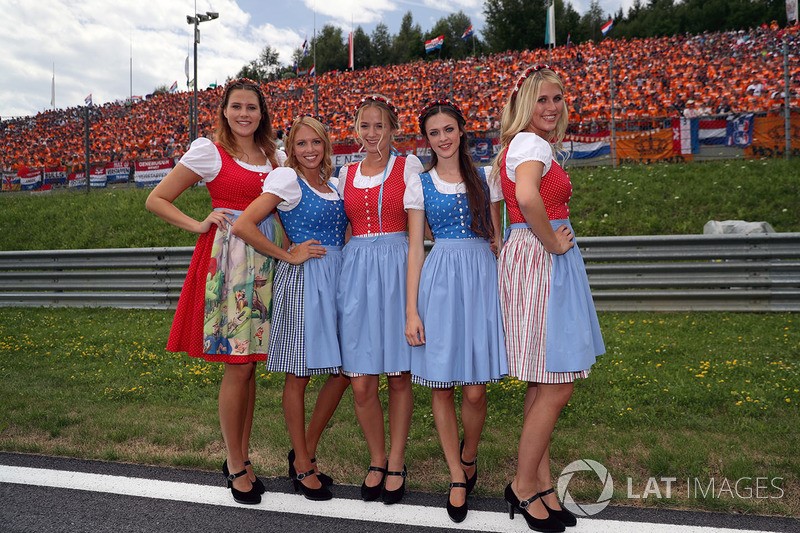
Formula 1 Austrian Grand Prix 2017, grid-girls.
Old Osterreichring loop could return to Red Bull Ring for F1 2017. By Ian Parkes, Gerhard Kuntschik. Published on Friday July 1st 2016.

The re-opening of the western section of the old Osterreichring is under review and could be in place for next year's Formula 1 grand prix at the Red Bull Ring.
The original Osterreichring was built in 1969 with a distance of 5.9km, but it was shortened in the 1990s and re-opened as the A1-Ring, with F1 races being held again between 1997-2003.
The circuit then closed and was revamped and renamed Red Bull Ring - under the ownership of Dietrich Mateschitz - with F1 returning again in 2014 after an 11-year absence.
Consideration has been given to a potential return of the original track's 'West Loop' to the outside of the current layout's Turns 1 and 2, with Red Bull consultant Helmut Marko recently saying that "at present, everything is still in the planning stage".
Mateschitz would have to apply to the Styrian government to seek specific permissions for the re-use of the additional 1.6 km of track that has been unused for motorsport for more than 20 years.
If sought and granted, it is understood resurfacing of the track and redevelopment to ensure it reaches current F1 safety standards, would take only a matter of months.
Extending the circuit would open the door to the potential staging of a World Endurance Championship race, while for F1, laptimes would increase significantly.
In first practice for this weekend's Austrian Grand Prix, Nico Rosberg's leading time of 1m07.373s was 1.5s faster than last year's pole time courtesy of car development and the use of this season's ultra-soft tyres.
It is anticipated lap times could easily be lowered to 62 or 63 seconds for next year's race given the changes in the regulations and alteration of the cars that will be running on wider tyres.
Red Bull driver Daniel Ricciardo said he would like to see the circuit extended.
"It would be cool to have a bit more distance on the track," he told the media.
"Next year, if the cars are going to be as quick as they say they are then the lap times are going to be close to a minute which is a very short lap, so it would create a bit more to the circuit.
"There is the space, I've heard a few people talk about it and it could be pretty interesting for us."
Mateschitz, meanwhile, has shelved his plan to buy and own a second racetrack in Austria, the Salzburgring, in a deal believed to be worth €3million.
Mateschitz has cited judicial reasons for his decision, as well as the actions of a local property owner regarding an area that is used as an entrance and car park.
Mateschitz said: "this person demanded €10,000 per month for the lease of a small area. At this point, it was enough.
"We intended to buy Salzburgring, though we did not have to. We can live without it.
"I have written a letter to the government of Salzburg stating we are no longer interested in buying."
F1 is back & Austria’s ever-changing circuit is the perfect place to start. Formula One in 2020 is just about to get back to business after threatening to begin in Australia in March.
With all the teams, drivers, sponsors and even fans ready for action at the iconic Melbourne circuit, the plug was pulled hours before Formula One was set to turn a wheel (which turned out to be the correct decision) but four months later, we will finally get to see the ten teams taking to the track in anger.
Europe is the destination for the resumption and Austria’s Red Bull Ring in particular and as one may suspect, Britain's Lewis Hamilton is the favourite with Betway at 15/8 as of the 1st July to make a winning start to the campaign.
Of all the venues in the world, the return to Austria is a fitting one as although the circuit has now adopted the name of its current owners Red Bull, there is plenty more than meets the eye to this circuit that makes it one of the great racing circuits on the F1 calendar today.
The early history.
Located in the rolling hills just outside the small city of Spielberg in the region of Styria in the southeast of Austria, those of you reading this may well remember the days when the circuit was known as the Österreichring as it was named when it was built.
The Österreichring was built to replace the rather bland Zeltweg Airfield circuit which boasted just four official corners with a lap record time of 1:04.820 set by Joe Siffert.
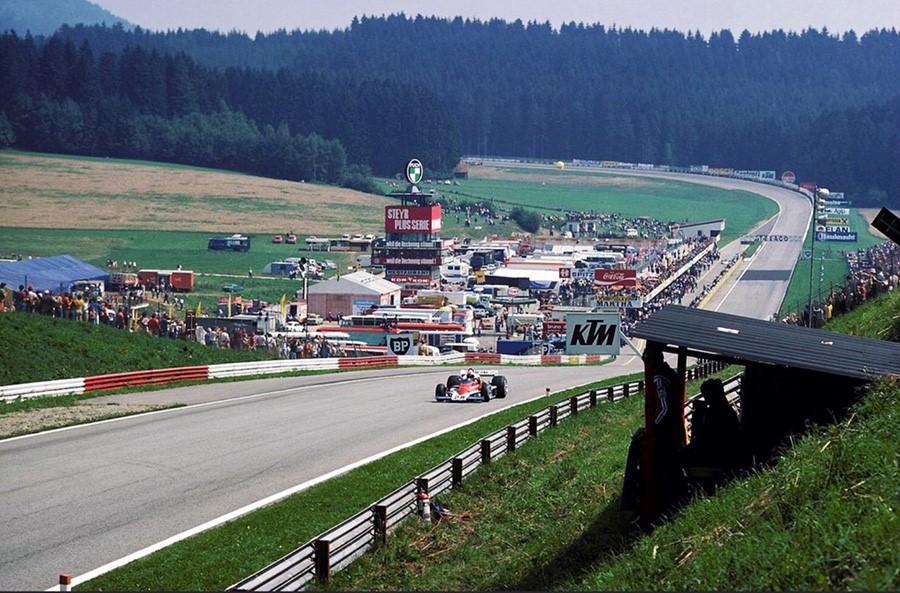
The airbase is still there today and is the venue of the AirPower show and since then Red Bull air races.
However, the Österreichring was created to give a more challenging experience for racers across the world and a year after it was built, it hosted its first ever Formula One World Championship event.
Ferrari’s Jacky Ickx took the chequered flag after an hour and forty-two minutes behind the wheel during the circuits debut F1 race with the track proving popular with drivers for its fast sweeping curves and powerful straights.
A1 Ring.
The tight nature of the Österreichring led to many safety concerns and in 1995, the circuit in its original state hosted its final Formula One race.
The following year, the circuit had a new name and a new look, The A1 Ring with the circuit shortened from its original 5.942 kilometres to 4.326 kilometres and the ultra-fast sweeping fast corners replaced by tighter turns to slow the track down.
The reason for the name change was due to mobile phone provider A1 contributing to most of the constructions costs although many die-hards still referred to the track as the Österreichring. Some still miss that old track but things have changed down the years.
The circuit was still well-regarded despite its shorter length and lower average speeds.
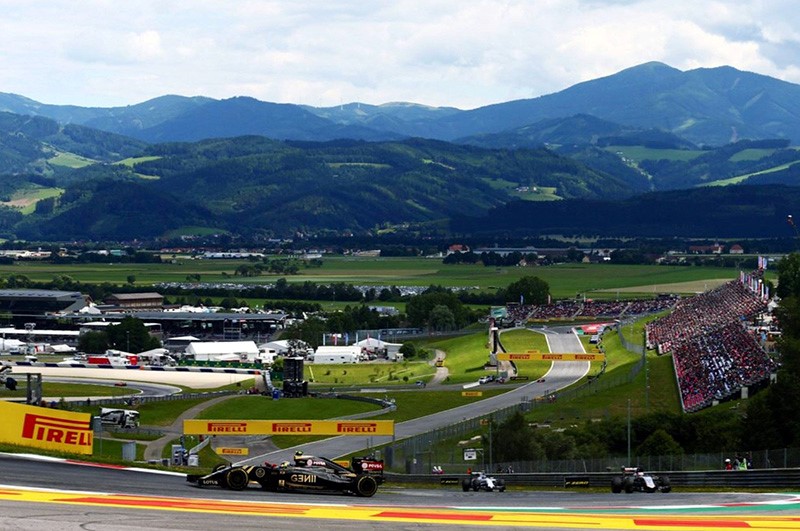
2011 – present.
2003 saw the final time the A1 Ring hosted Formula One but in 2011, Red Bull purchased the site with the intention of getting the circuit back on the calendar.
In 2013, it was reported that Red Bull owner Dietrich Mateschitz and F1 supremo Bernie Ecclestone had reached an agreement to host Formula One in 2014 and that is exactly what happened with the circuit returning to the F1 calendar after an eleven-year hiatus.
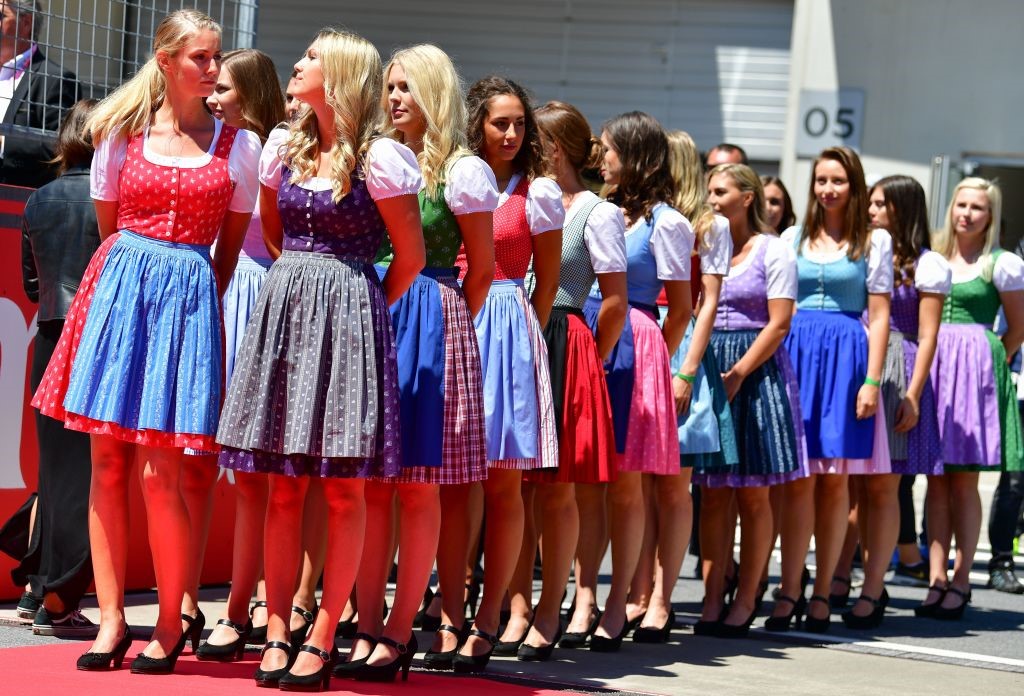
Ladies wearing traditional Dirndl dresses get ready before the start of the Austrian Formula One Grand Prix in Spielberg.
Since then, the circuit has become a major player in Motorsport also hosted the Moto GP as well as a Red Bull air race event.
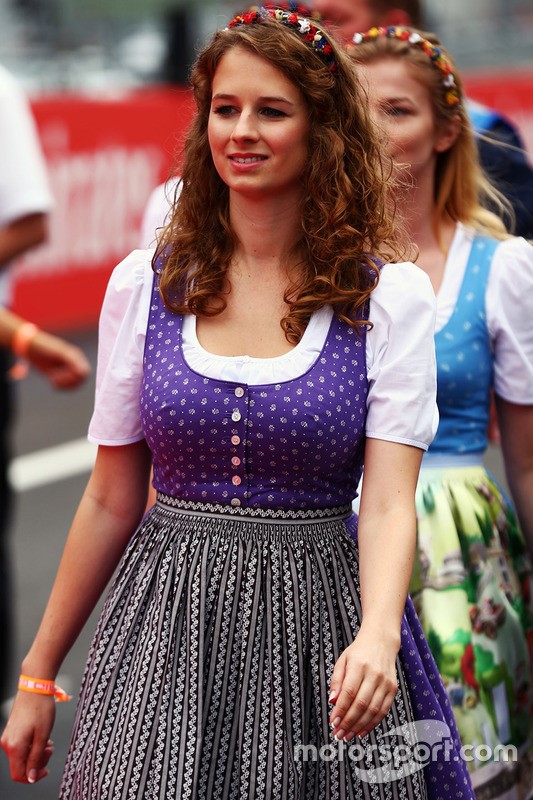
Grid girl at Austrian GP 2016.
Now, the circuit has the honour of getting the 2020 season back underway with back to back F1 races on the 5th and 12th of July and we are sure there can be few doubts that the Österreichring, A1 Ring, Red Bull Circuit or whatever you would like to call it is a more than deserved place to begin.
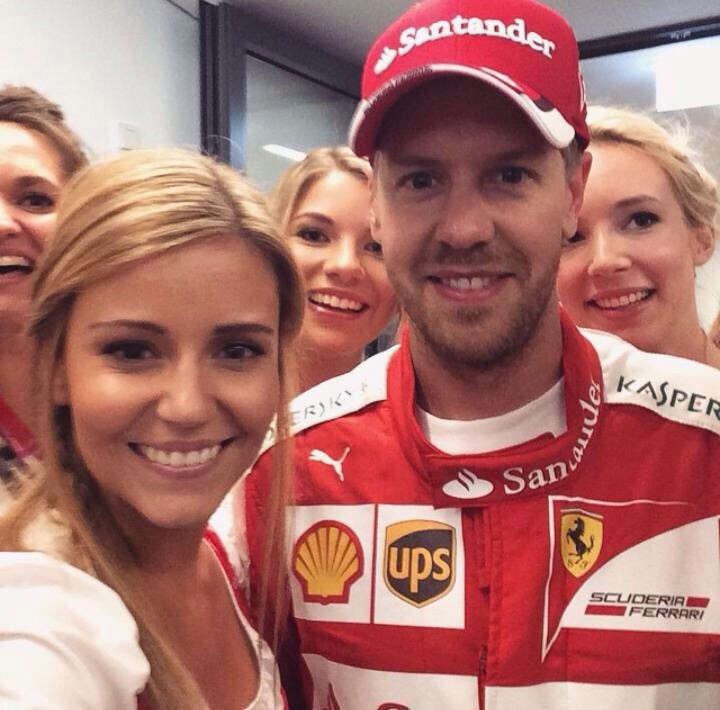
Sebastian Vettel at Austrian GP 2016.
All eyes will be on Austria this weekend.
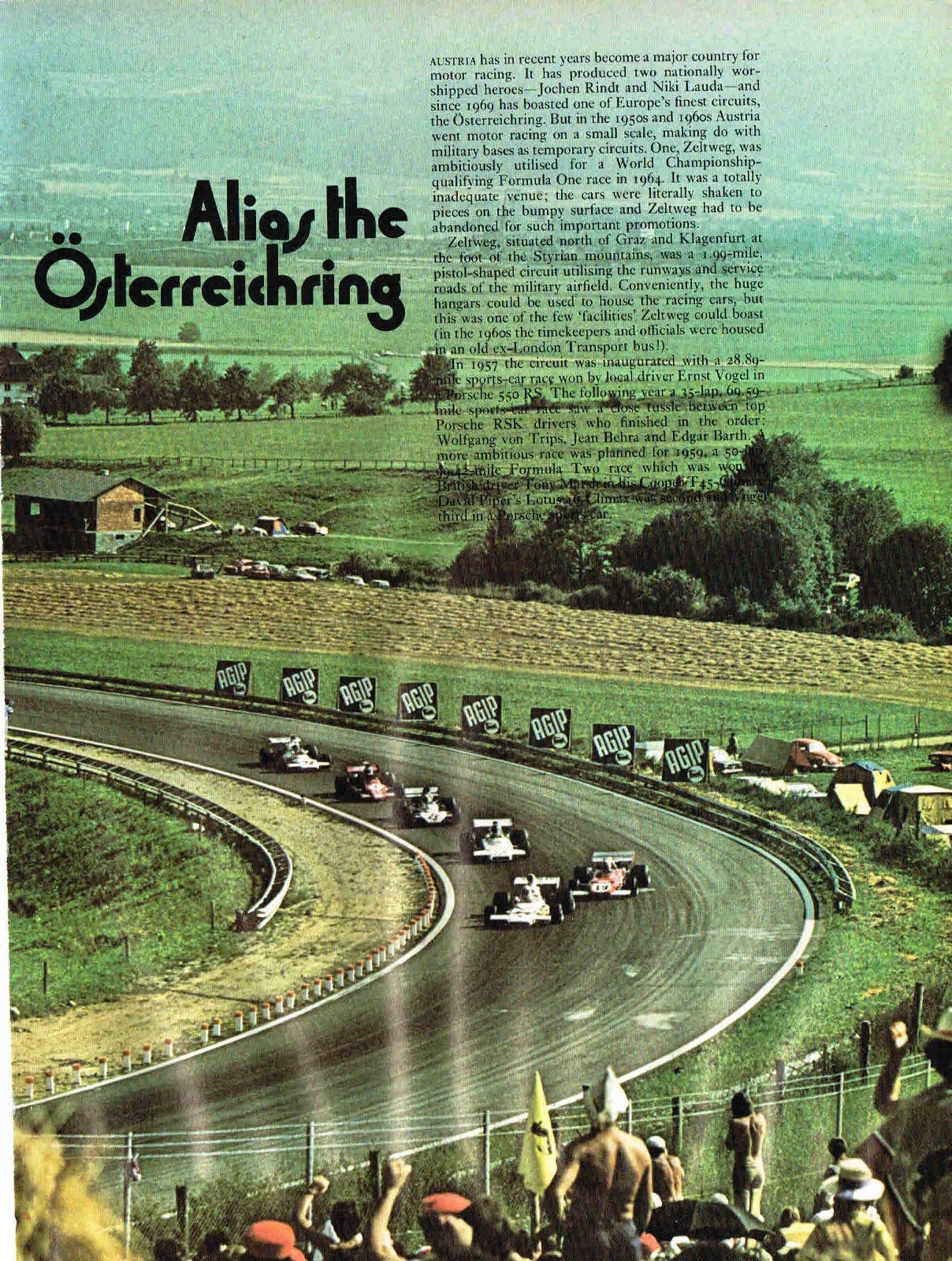
John Watson: F1 has lost the challenge of the old Österreichring. July 1st 2020. By Damien Smith.
Formula 1 begins its season at Austria's Red Bull Ring, a circuit that's a shadow of its former self. John Watson recalls the mesmerising Österreichring.

Niki Lauda, McLaren, at the Österreichring in 1984.
“Here’s the thing,” says John Watson of the old Österreichring, scene in modern form as the Red Bull Ring for this Sunday’s delayed and much-anticipated Formula 1 season opener. “If someone could do a simulation of the old circuit and get Lewis or ‘Mad Max’ to do a 10-lap run, then tell us how it compares to the track we have today, I think I know what they’d say. It’s incomparable to what it was.”
An old racing driver telling a younger generation they don’t know they’re living, never mind even born? They’ve heard it all before… But in this case, for anyone who visits the beautifully maintained Red Bull Ring in its stunning Spielberg mountain setting, it’s hard not to think about what’s been lost – especially as the old ribbon of track still stretches off as an unused relic beyond Turn One. The Österreichring is up there with the old Spa-Francorchamps as one of the world’s great race tracks left behind by a changing world.
But unlike Spa, it’s not as old as it appears. The first world championship-counting Austrian GP was held nearby at the Zeltweg aerodrome in 1964, on a forgettable, bumpy L-shaped track that was as suited to purpose as a communal park football pitch for the FA Cup Final. But when the world championship next returned to Zeltweg, in 1970, it was to a stone-cold classic track that had been carved out of picture-postcard Alpine scenery. It’s easy to imagine Nuvolari, Caracciola, Fangio and Moss sweeping through Hella-Licht and the Bosch Kurve – even though they never did.
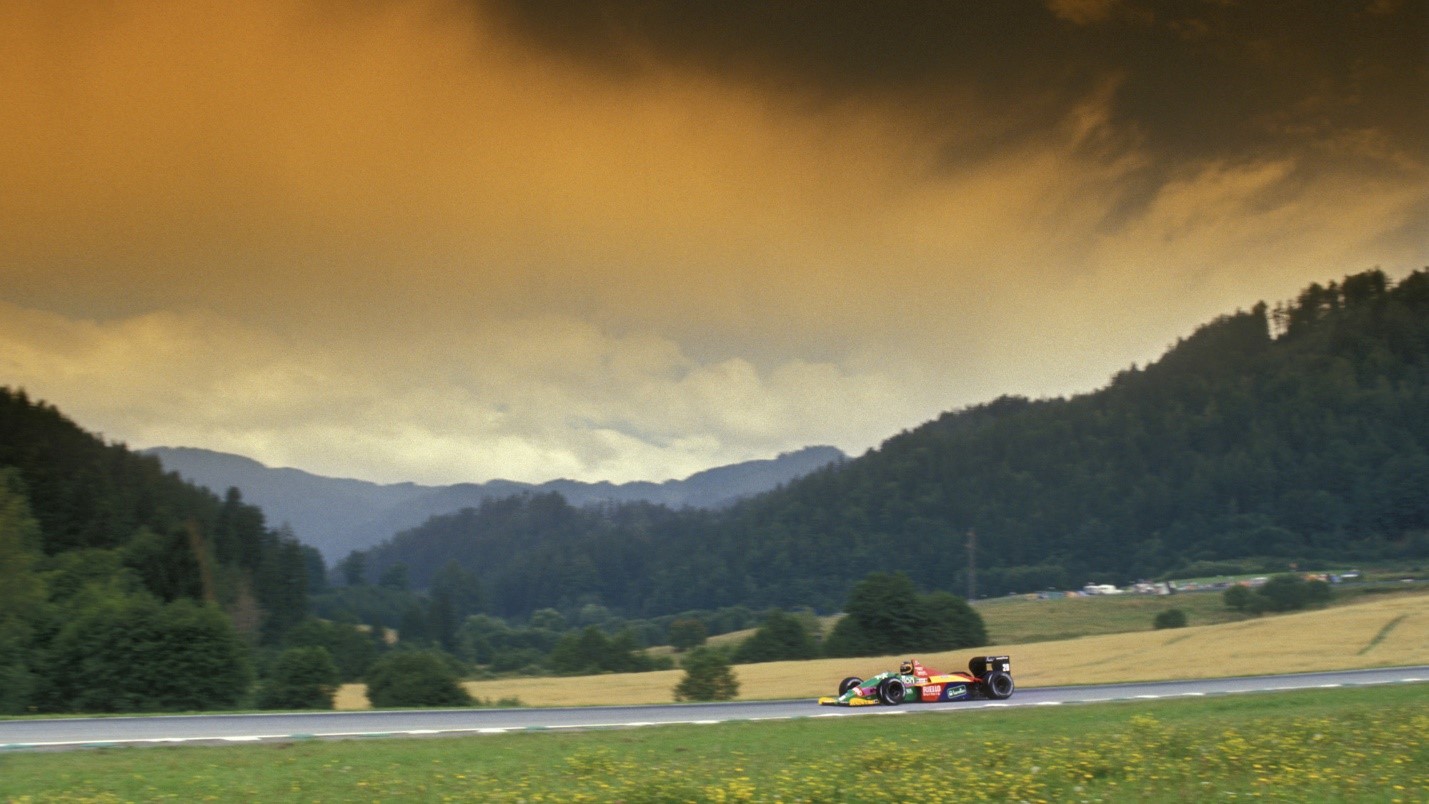
Thierry Boutsen in the picture-postcard scenery during the 1987 Austrian Grand Prix. Grand Prix. Photo / Dominique Leroy.
“I first raced there in 1973 for the Gulf Mirage team in the 1000Kms sports car race,” says Watson “and what stood out was in every sense it felt like a road circuit, except it was actually a permanent one. I never raced on the old Spa, but it had echoes of that kind of circuit: flowing with fast, long corners.”
Watson would subsequently race in 10 Austrian GPs at the Österreichring between 1974 and ’83, finishing fourth first time out in Hexagon Racing’s privateer Brabham BT44 and most memorably claiming Penske’s first and only F1 grand prix victory in 1976, one year after team talisman Mark Donohue and a marshal died following a tyre failure. The marshal was killed by debris, although Donohue appeared to have escaped serious injury, only for a headache to worsen and a cerebral haemorrhage to claim him two days later.
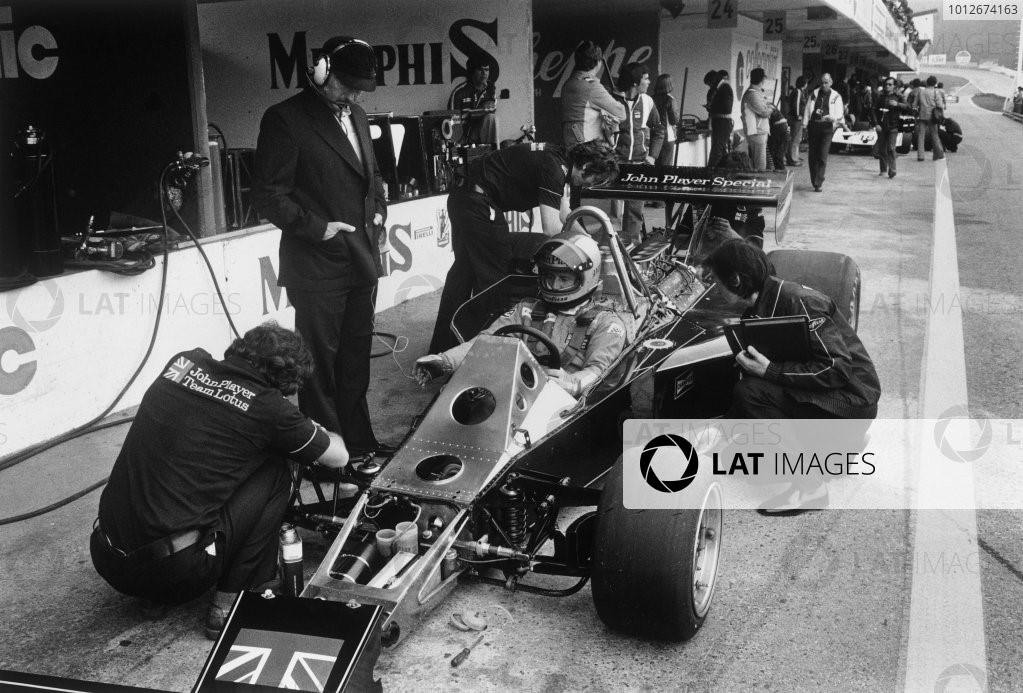
1976 Austrian Grand Prix. Osterreichring, Zeltweg, Austria. 13-15 August 1976. Mario Andretti (Lotus 77-Ford), 5th position, in the pits during practice, action. World Copyright LAT Photographic. Ref BW Print.
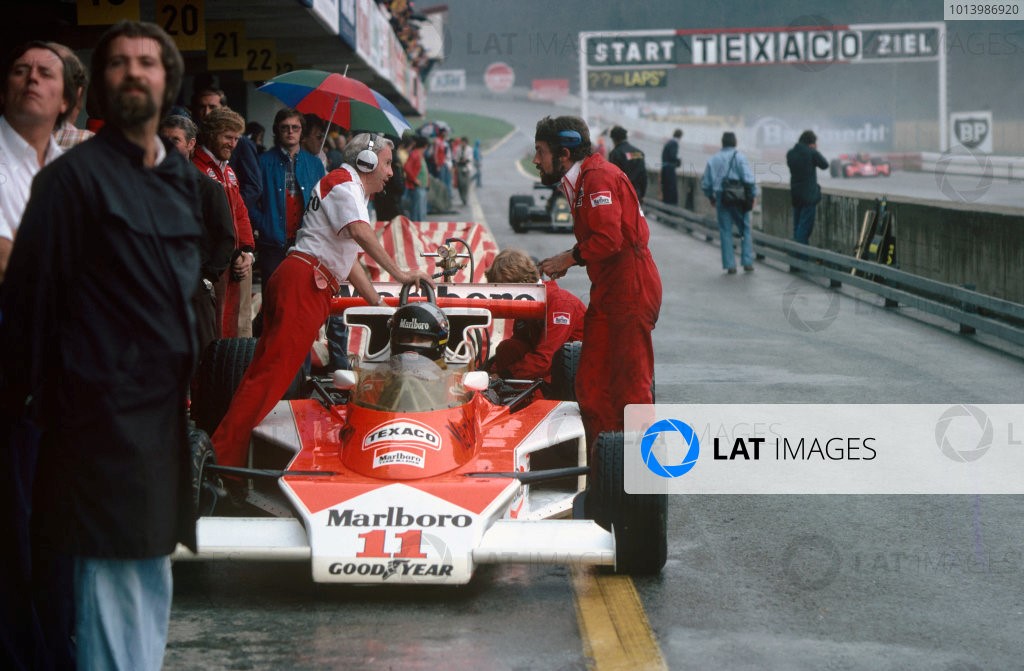
1976 Austrian Grand Prix. Osterreichring, Zeltweg, Austria. 13th - 15th August 1976. James Hunt (McLaren M23-Ford), 4th position, in the pits, action. World Copyright LAT Photographic. Ref 76 AUT 14.
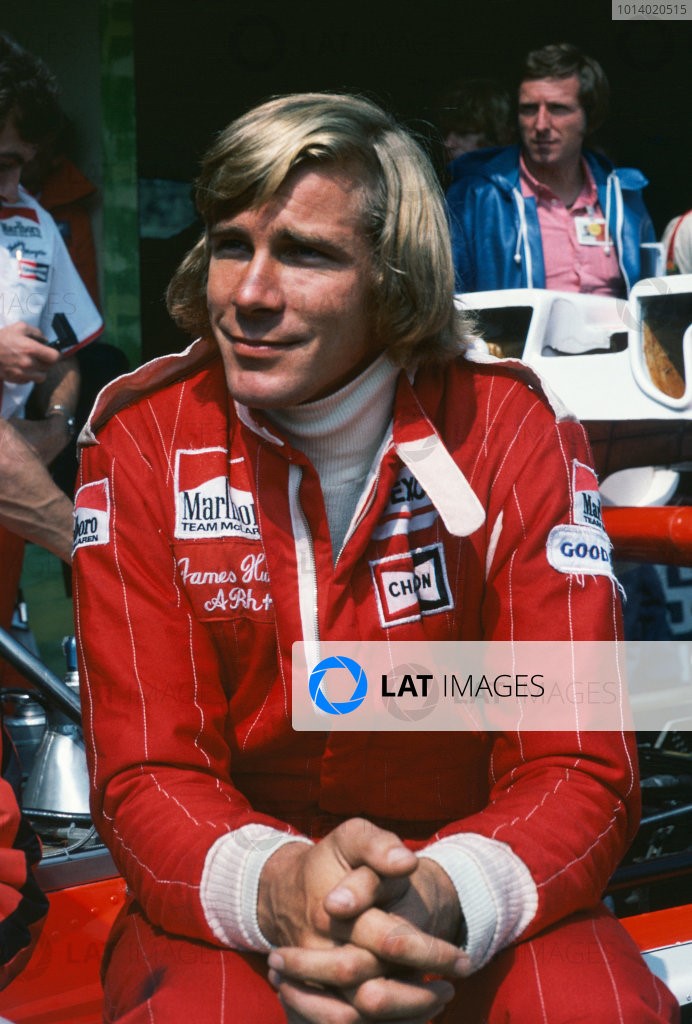
1976 Formula 1 World Championship. Osterreichring, Zeltweg, Austria. 13th - 15th August 1976. James Hunt (McLaren M23-Ford), 4th position, portrait. World Copyright LAT Photographic Ref 76 AUT 17.
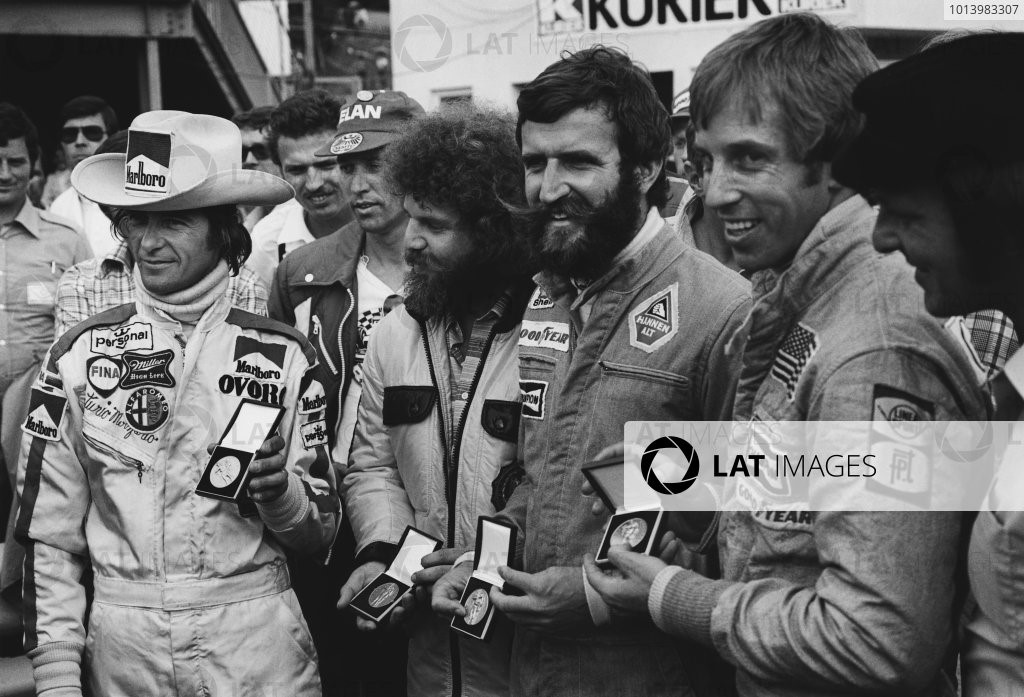
1976 Austrian Grand Prix. Osterreichring, Zeltweg, Austria. 13th - 15th August 1976. Arturo Merzario, a representative of Guy Edwards, Harald Ertl and Brett Lunger receive medals for saving Niki Lauda from his near fate.
“There was a poignancy going back for Roger Penske and [team manager] Heinz Hofer a year later,” says Watson of 1976. “But there was no wearing of armbands or walking around in a morose frame of mind. Roger is a pragmatist: what has happened has happened, you can’t change it. He’s a bit like Bernie Ecclestone in that respect. We can’t bring the guy back, we’re here to do a job, let’s do the best we can. That was a positive approach and I have no doubt that contributed to our success that day.”
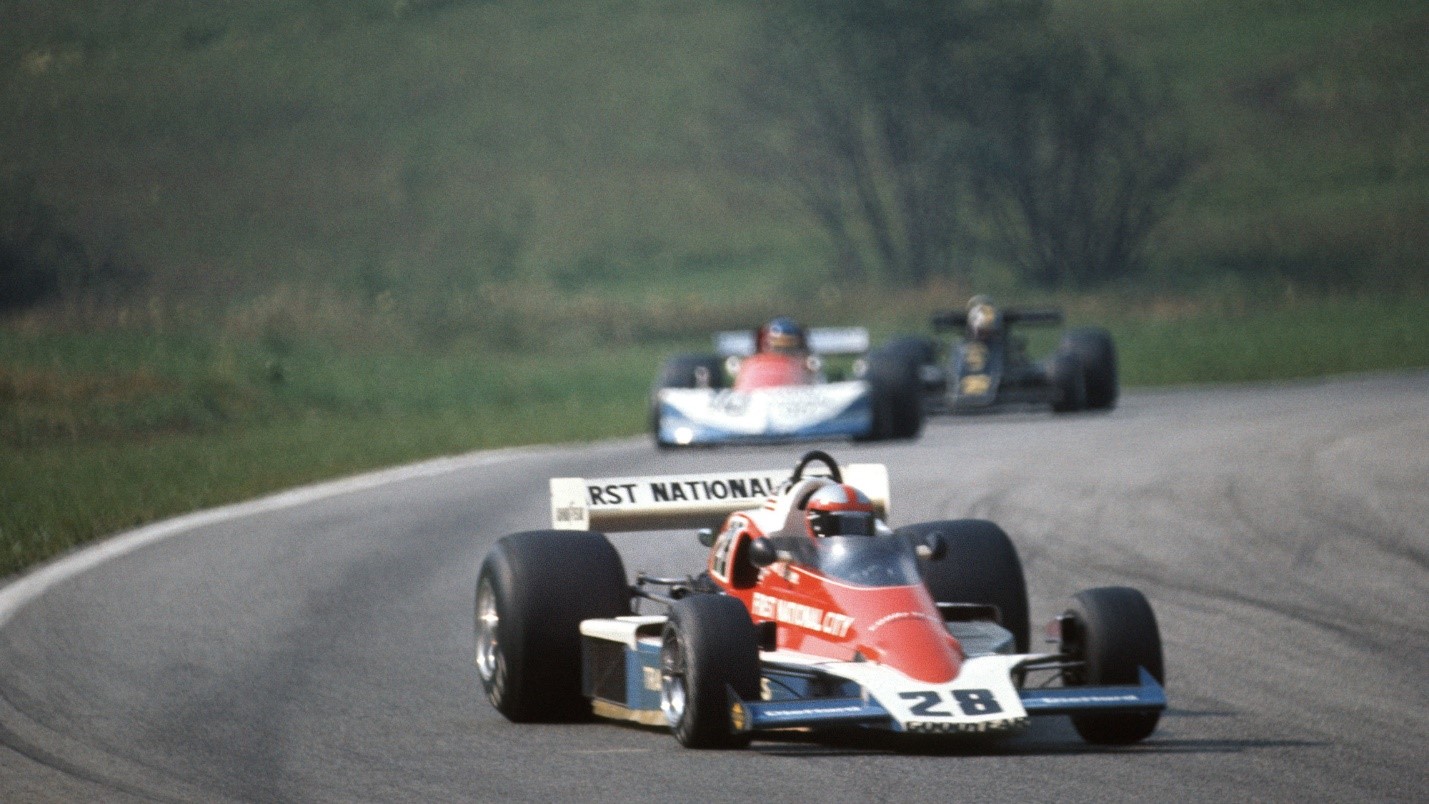
John Watson on his way to a poignant victory in 1976. Grand Prix Photo.
Watson has only happy memories of a circuit that he admits left him wide-eyed, but appeared to be nothing out of the norm for the time. “Going up into Hella-Licht, the corner past the pits that was slowed by a chicane after Mark’s accident, was an eye opener because you were doing 170 mph up to the top of the crest, then turning right,” he says. “That is not the sort of thing you get at Kirkistown, scene of my formative years… it was probably the quickest corner I’d taken in my life. But once you get your head around it, it was a great and challenging corner. Very marginal. The car would be teetering on the point of oversteer, which if it overstepped would not lead to a great outcome. But it was what race tracks where all about, to challenge drivers.
“For sure, there were dangers, particularly at the Bosch Kurve because you’d begin the return leg at the top of the hill and approach Bosch at 170-180 mph. There was no run-off, the barrier was right beside the track and that was it. The point that is lost today is those challenges made my generation more respectful and also allowed those with a supreme talent to shine above those who were something less. Today everything is brought down to the lowest common denominator. A young guy like Lando Norris can jump into an F1 car and be very competitive. If he’d done the same in 1973 he wouldn’t have known if he was punched, bored or countersunk…”
In contrast, Watson describes the shorter, toned down version we know as the Red Bull Ring as “emasculated” and “anodyne”, while acknowledging the two-corner infield section and the fast Rindt right-hander leading into the final turn still offer a decent challenge for today’s generation. “But there was something about a proper, free-flowing race track that allowed a driver to express himself,” he says. “He was able to create his own masterpiece on that canvas. I don’t think anyone can suggest you can do that on the Red Bull Ring, even if everything is ‘appropriate’ for modern F1.”
The Österreichring will always be special for ‘Wattie’, because of 1976. “I went from being a grand prix driver to being a winner,” he says. “That’s a step forward. Austria has always been special because it was my first.”
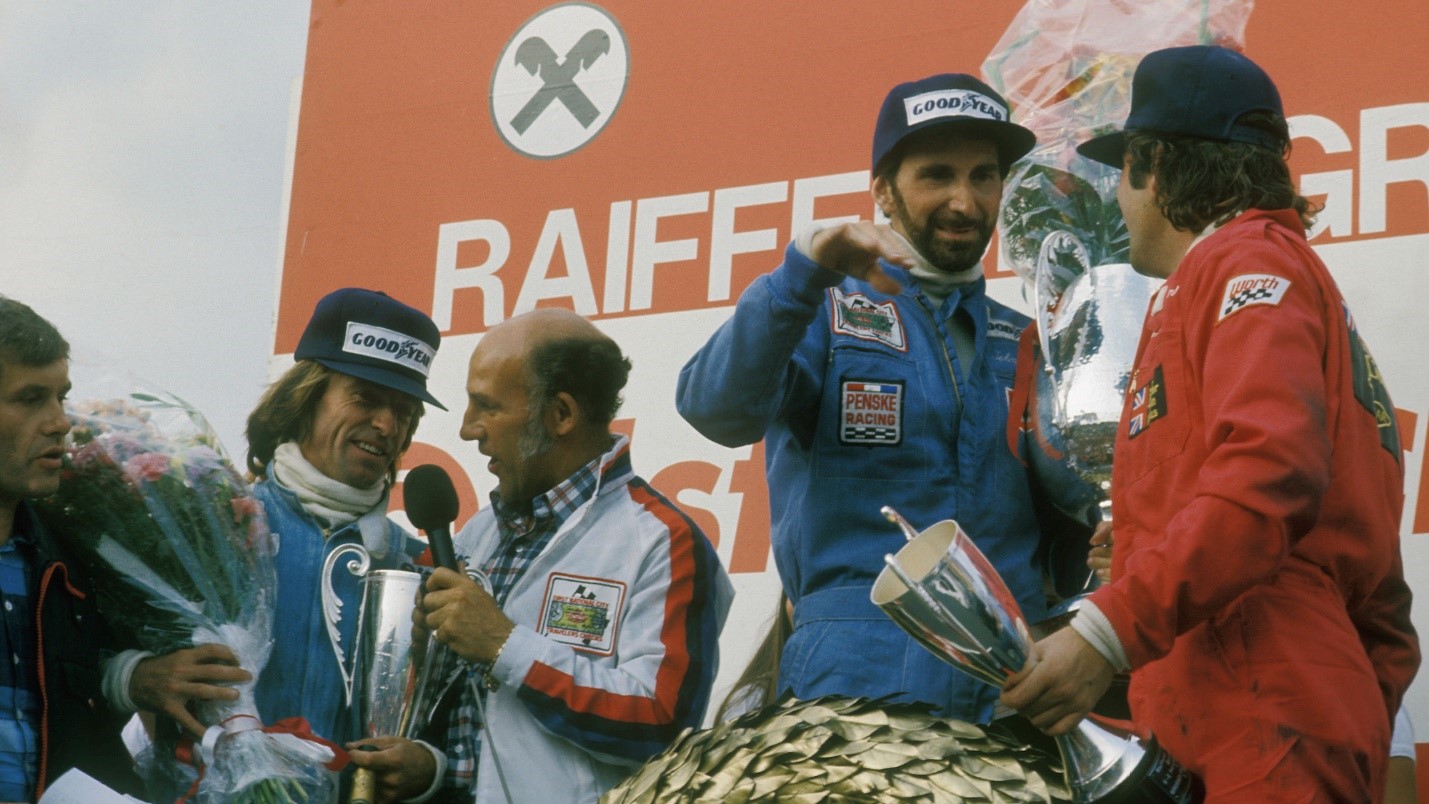
A final glimpse at the bearded Watson on the top step of the podium in 1970. Grand Prix Photo.
It also changed his life in a more physical, visual way… “I’d promised Roger I’d shave my beard off because I was the only person on the team with any facial hair,” he says. “After the race we flew back to London and stayed at Heathrow because Roger was flying out on Monday morning. When I got to my bedroom at the hotel, the first thing I did was go to the bathroom with my wash bag, get the razor out and shave the f***ing thing off. To be honest, I’d been wanting to get rid of it anyway – 1976 had been a particularly hot summer. But when I looked in the mirror, I thought ‘oh my God, what have I done?’ I hadn’t seen the rest of my face since 1968!
“The next morning I was the first one down in the coffee shop and I waited for Roger and Heinz to come in. When they did, Roger said ‘where’s Watson?’ I sat there, didn’t give any signal but shouted ‘here, Roger!’ He knew the voice, but he couldn’t see me until I put my hand up and waved. I think he was surprised I’d fulfilled my part of the deal as quickly as I had done. The podium was a great moment and shaving the beard off that night was next to it.”
The beard never returned. As for the Österreichring, it survived until 1987, after which financial problems added to the pressures on a circuit increasingly out of step with a changing sport. When it returned in truncated form, first as the A1-Ring in 1997 and again under Red Bull ownership in 2014, the circuit conformed to modern F1 expectations. But for Watson and his ilk, that’s exactly why it never will be a patch on what it once was. In truth, it never could be.
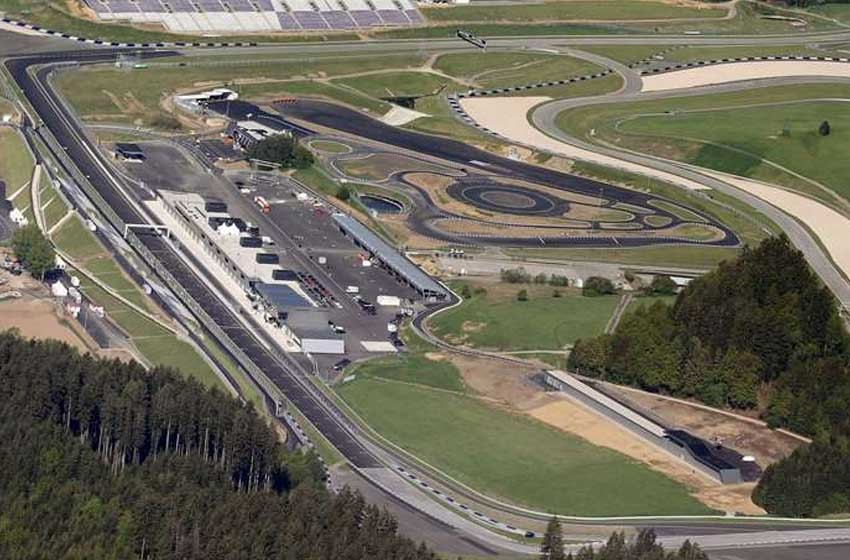
Zeltweg airfield.
Wild Times: Historical photos from the first Austrian GP. © Motorsportarchiv. A look back to the first Formula 1 race held on the then brand-new Österreichring 50 years ago. Written by Werner Jessner. Published on 03.07.2020.
A fresh start.
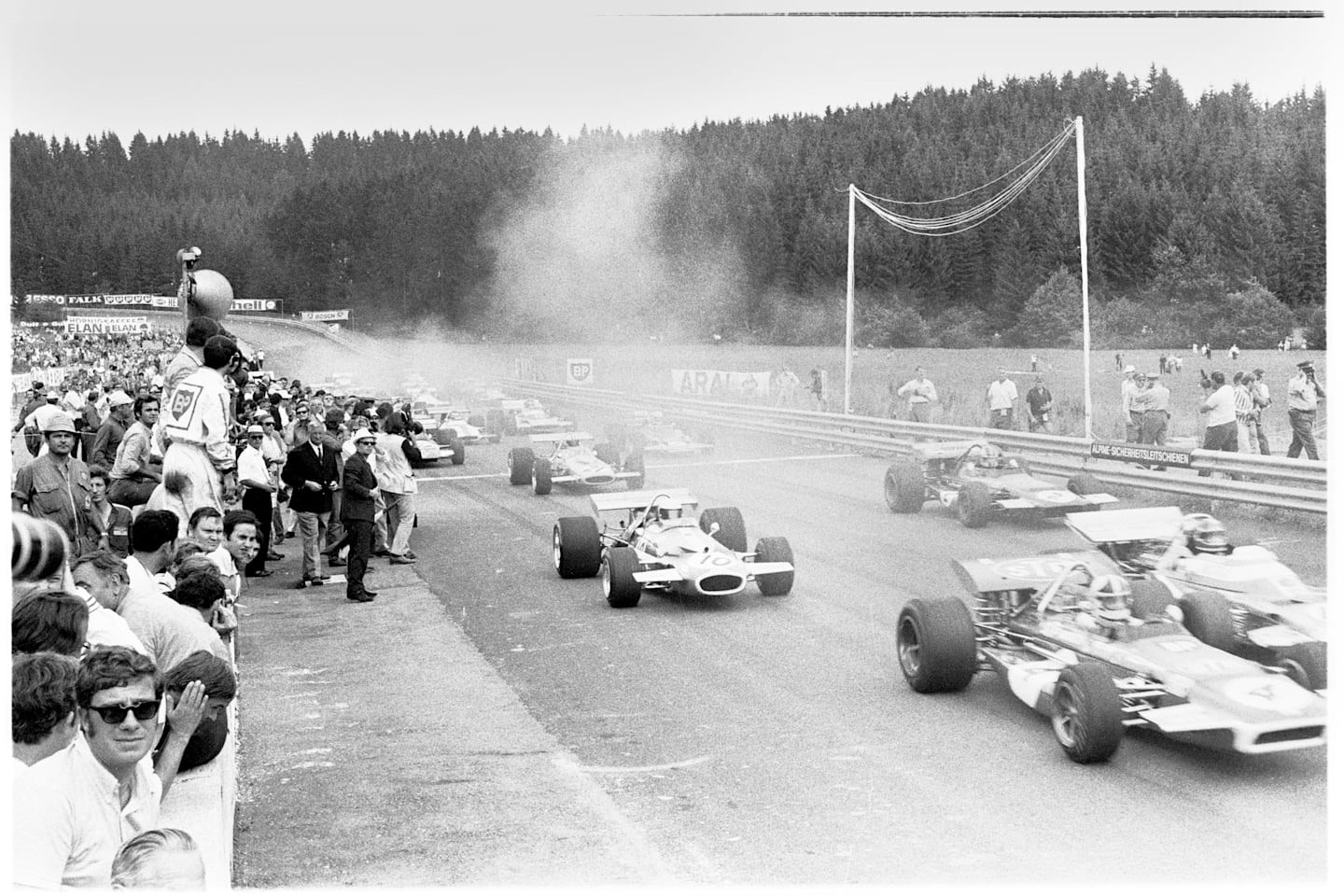
The Osterreichring grid on August 16, 1970. © Motorsportarchiv.
The first-ever start on the purpose-built Österreichring, which replaced the old Zeltweg circuit.
Running repairs.
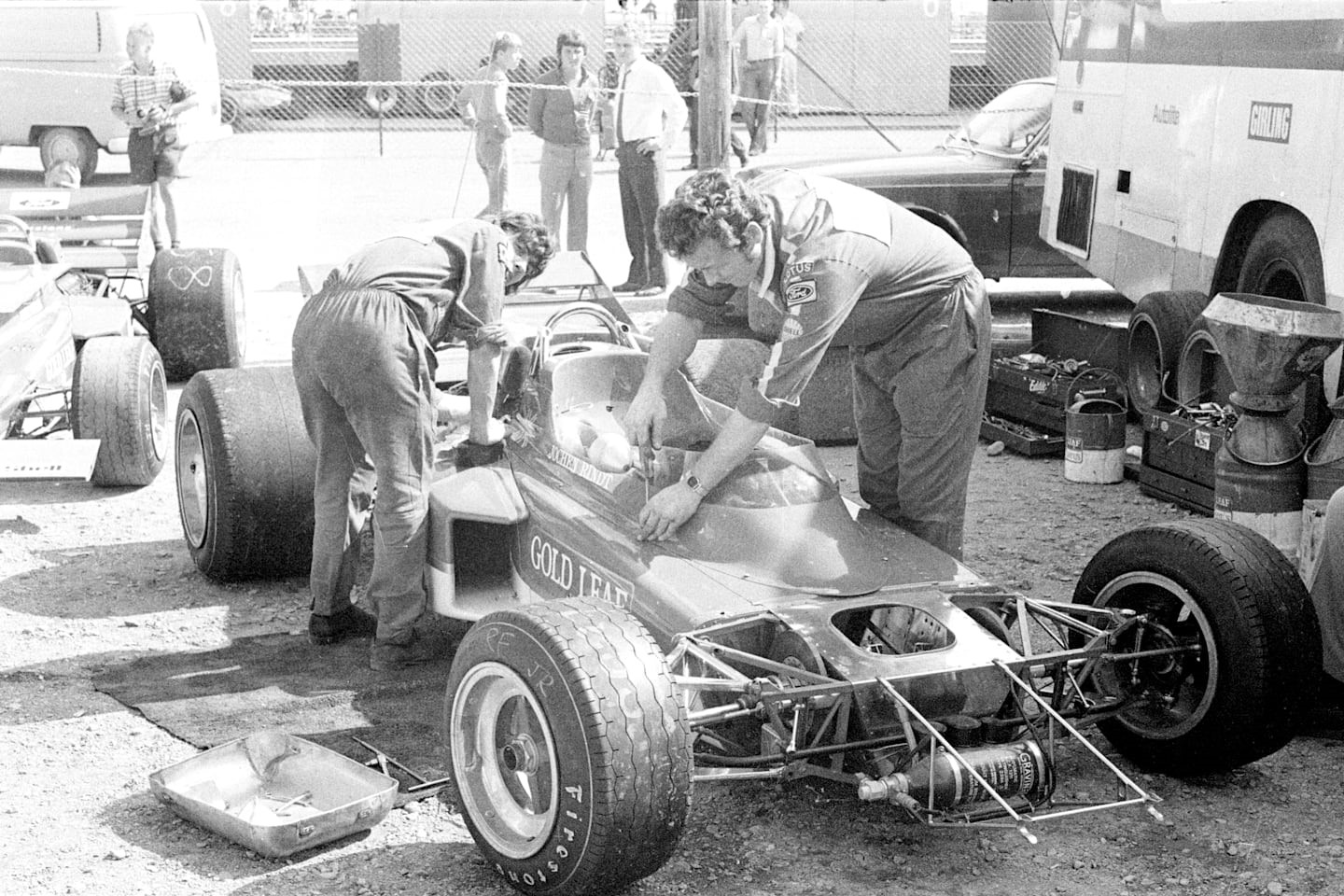
The Lotus 72 only went and conked out again at Jochen Rindt's home race. © Motorsportarchiv.
Jochen Rindt’s Lotus 72 broke down at his home race. It was the last race at which he left the car alive.

Zeltweg 1972.
Close shave.
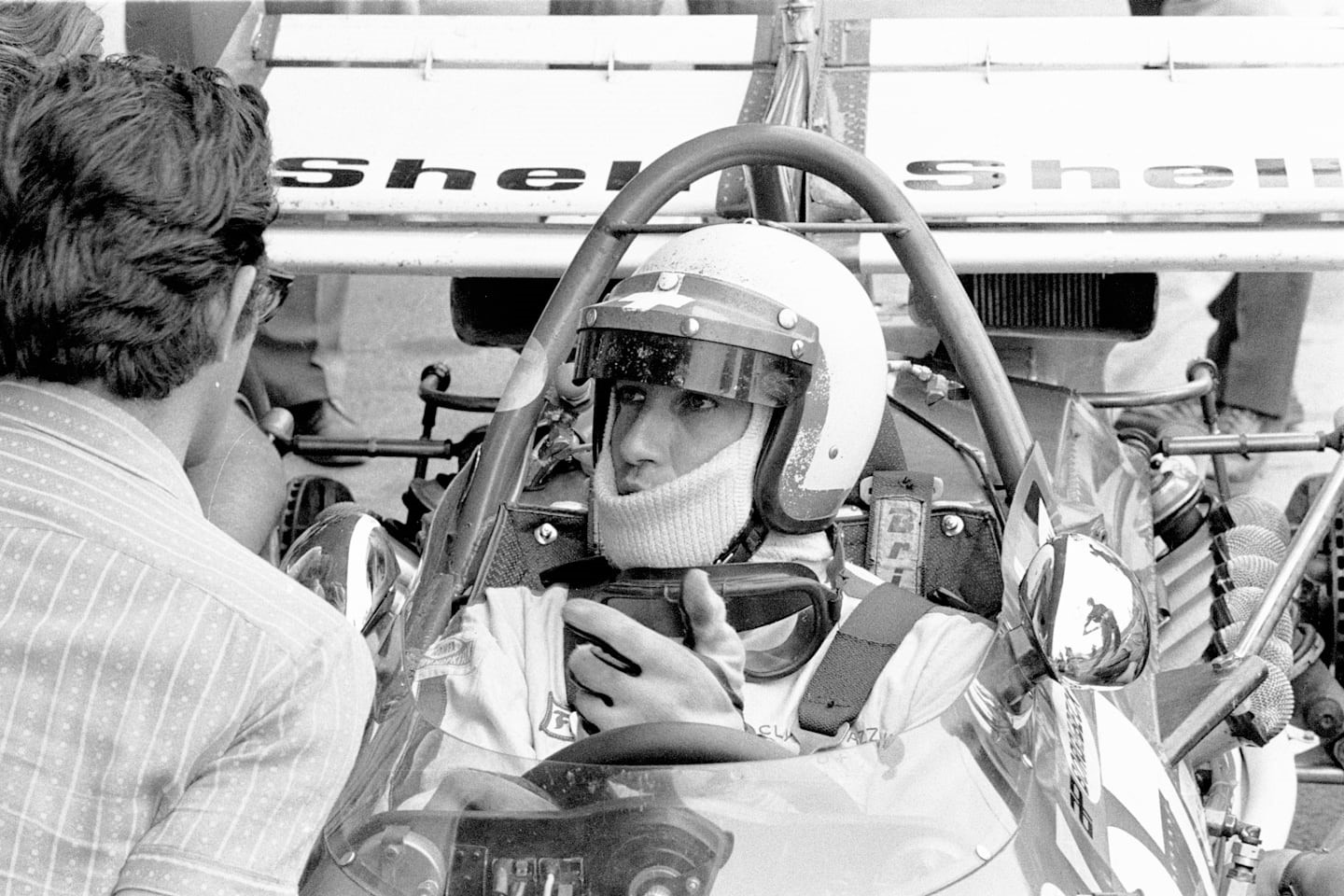
Clay Regazzoni started his F1 career in 1970 at the grand old age of 30. © Motorsportarchiv.
Flamboyant Swiss Clay Regazzoni in his rookie season at the age of 30. That trademark moustache – and his partnership with Niki Lauda – came later.
Cool in the shade.
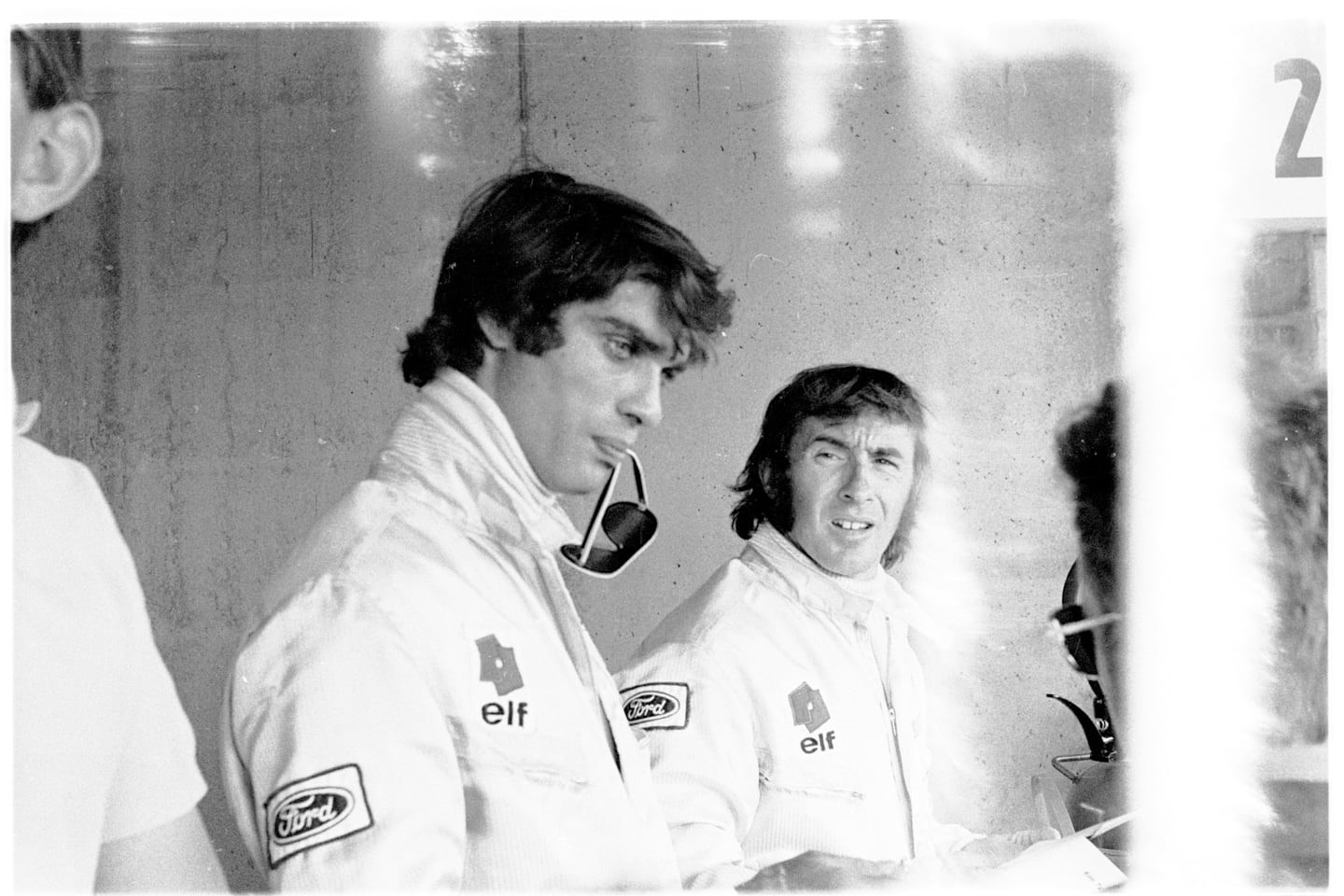
Here we see Jackie Stewart and François Cevert in the pits. © Motorsportarchiv.
Defending Formula 1 world champion Jackie Stewart and Tyrrell team-mate François Cevert – then a rookie at his fifth grand prix – look cool as they take shelter from the fierce sun.
Fast bucks.
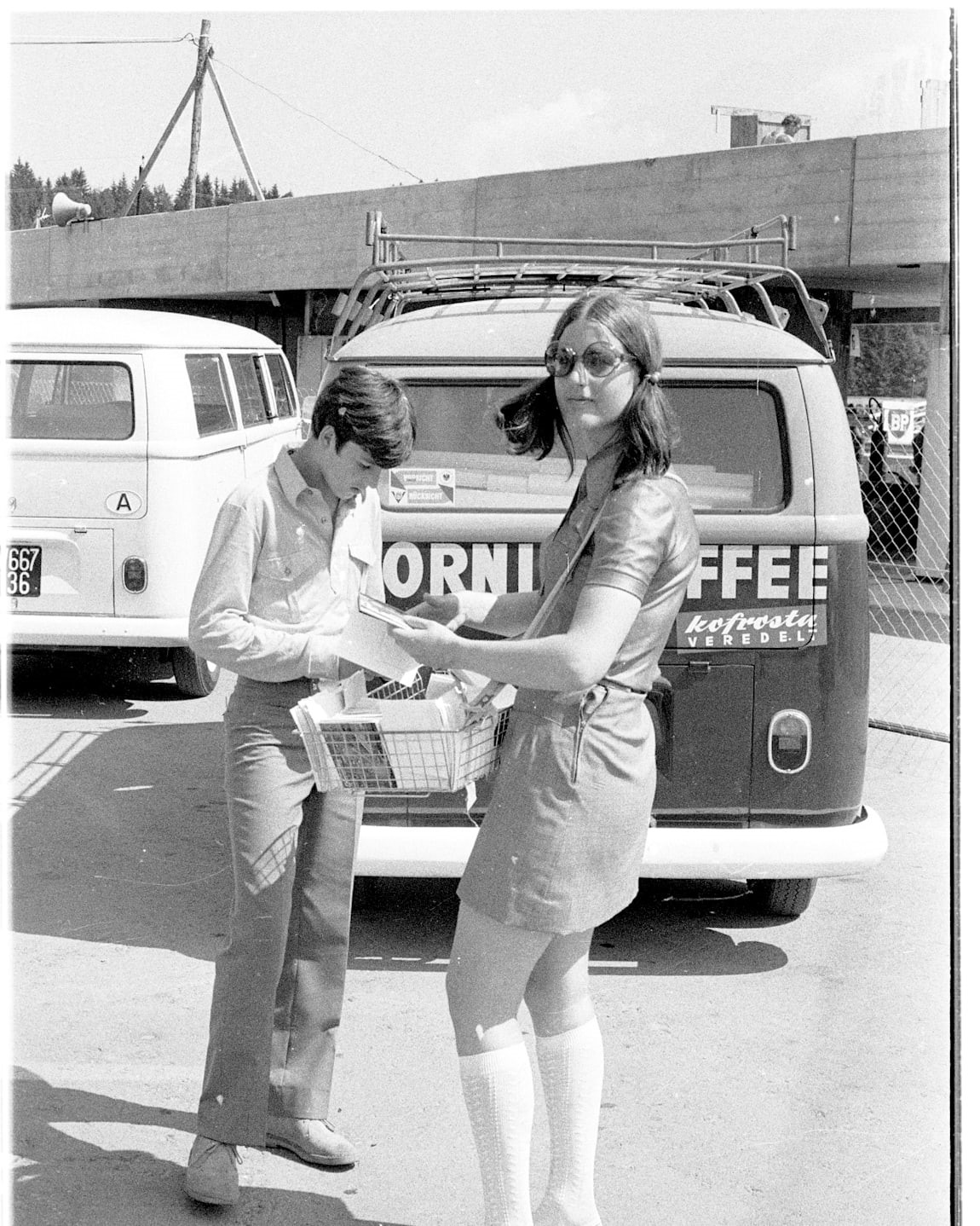
Vendors: the GP would prove to be a valuable source of income for locals. © Motorsportzarchiv.
The Austrian Grand Prix quickly became a valuable source of income for families living in the Mur valley.
Historic.

The crowd loved the new circuit and so did many of the drivers. Austrian GP 1970, Jean Pierre Beltoise. © Motorsportarchiv.
The fans loved the new circuit and so did many of the drivers. Jean-Pierre Beltoise in the Matra takes the chequered flag in sixth to take the last championship point of the weekend.
Safety, '70s style.

Jochen Rindt's team-mate John Miles escapes his Lotus wreck. © Motorsportarchiv.
No Armco or run-off but Rindt’s team-mate John Miles got out of the wreck of his Lotus in one piece.
Picture perfect.
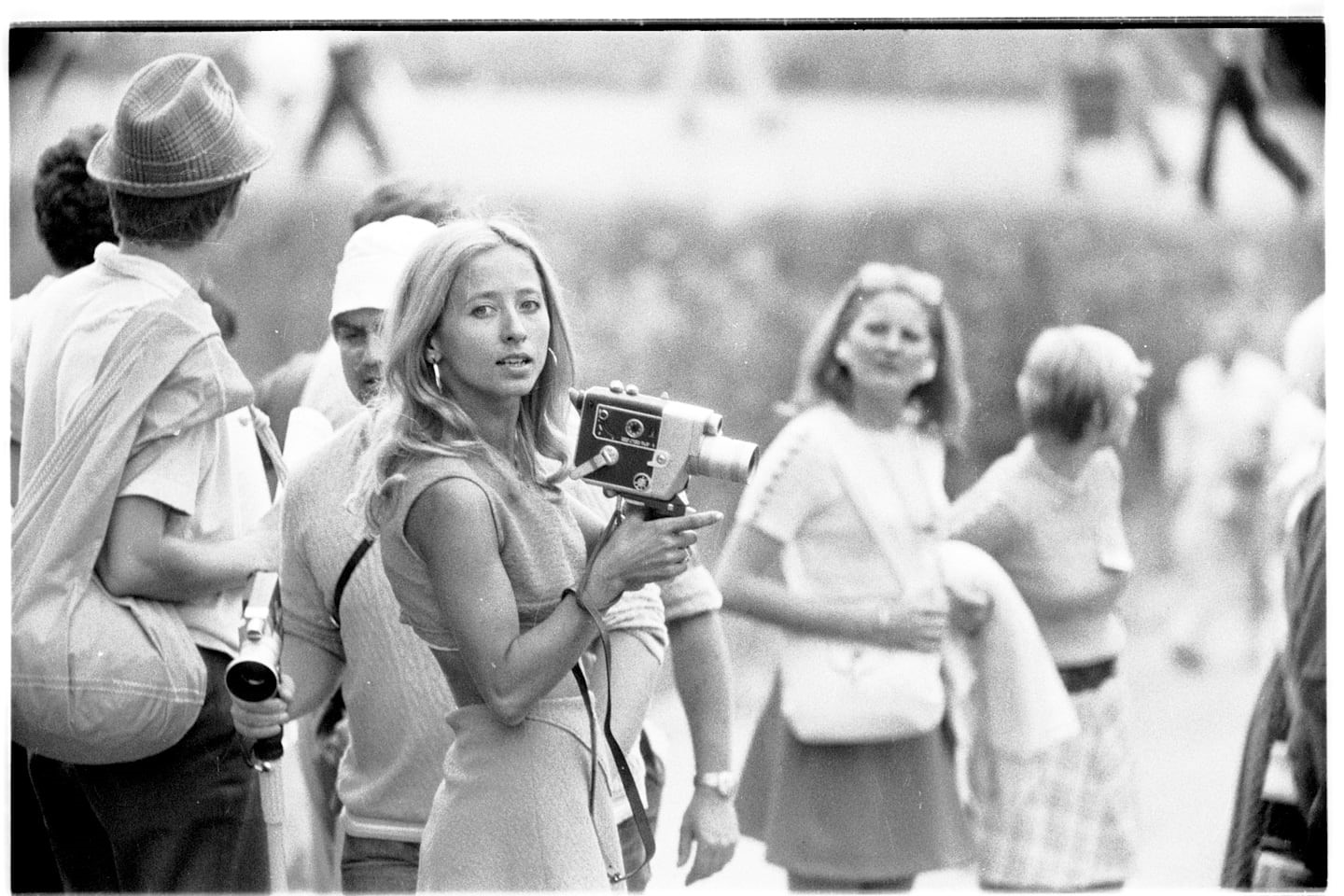
Before GoPro and 5K, Formula 1 was still worth filming. © Motorsportarchiv.
It may be before GoPros and 5K but Formula 1 was still fabulously cinematic – although taking a selfie wasn’t quite so easy.
Drivers' parade.
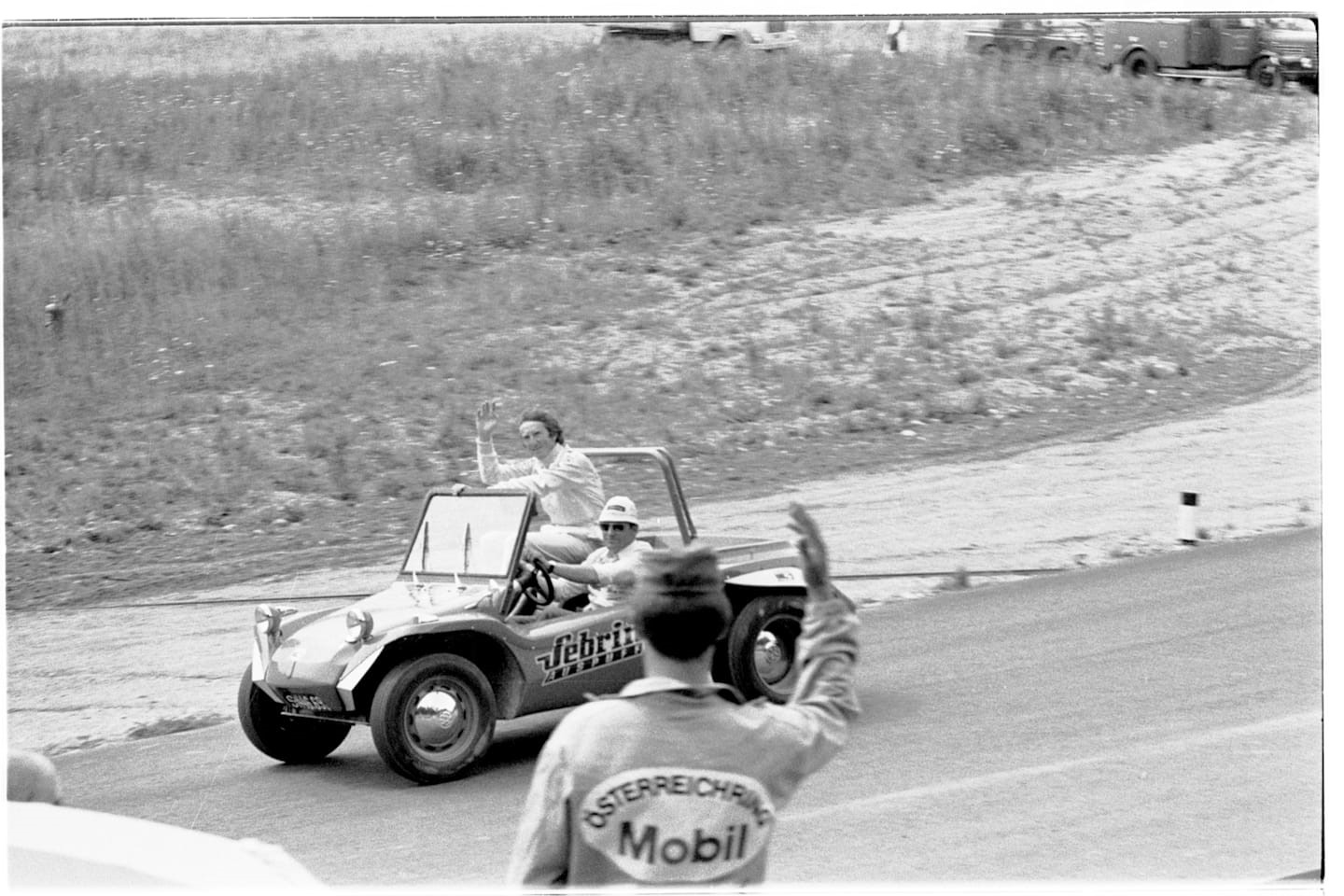
Drivers' parade. © Motorsportarchiv.
Rindt waves to the enthusiastic fans at his home grand prix. Buggies were the must-have accessory at the time. Unfortunately, the same can’t be said of the driver’s beach hat.
Touching.
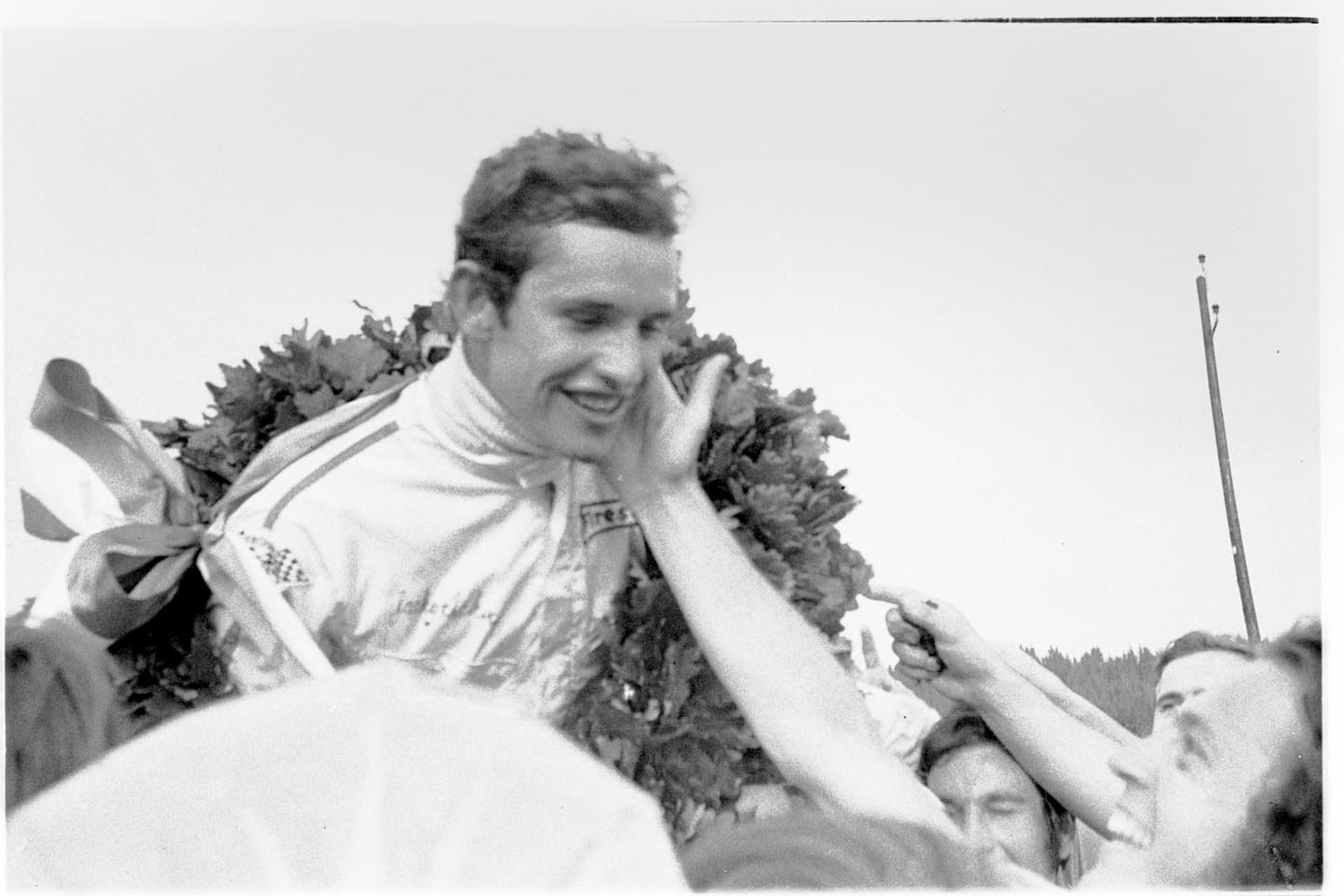
Jacky Ickx went down in history as the first winner in a Ferrari. © Motorsportarchiv.
Jacky Ickx wins for Ferrari, to the delight of the Tifosi but to the dismay of the locals who had hoped to see pole-sitter Jochen Rindt on the top step.
Frank Williams shows his loyalty. He and Jochen had become close friends as they forged their careers in junior formulas.
Videos



Comments
Authorize to comment